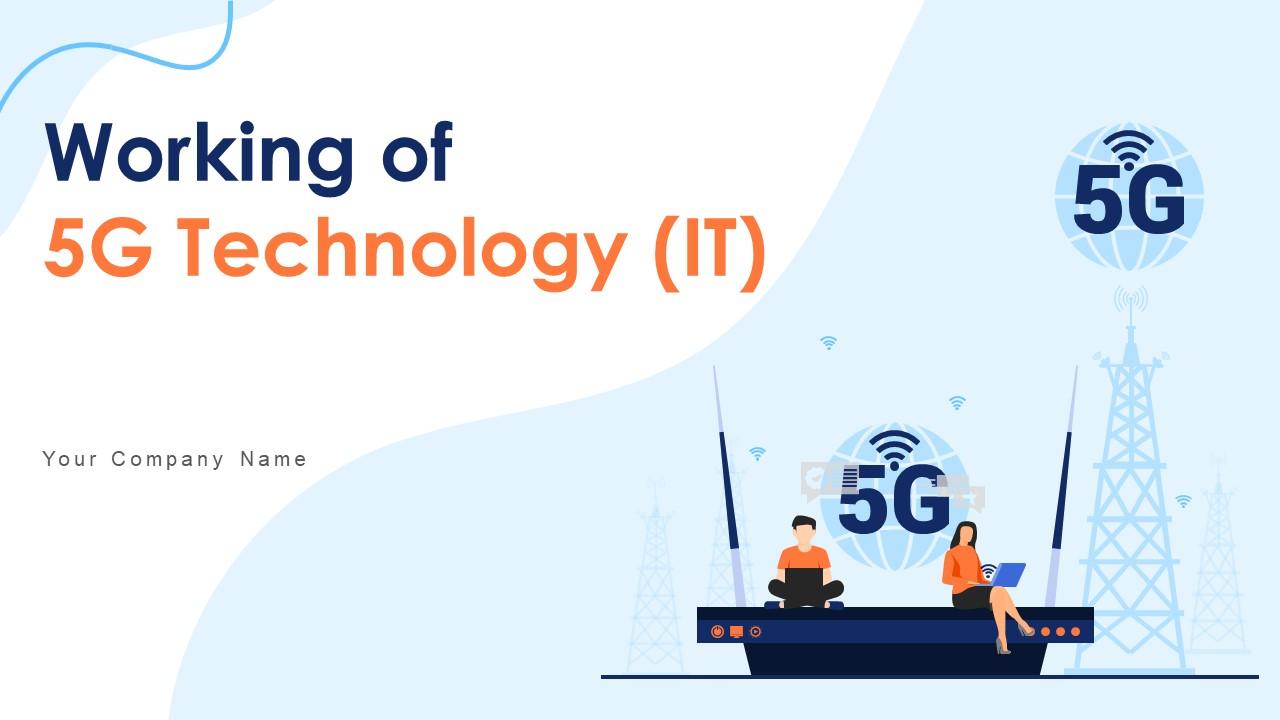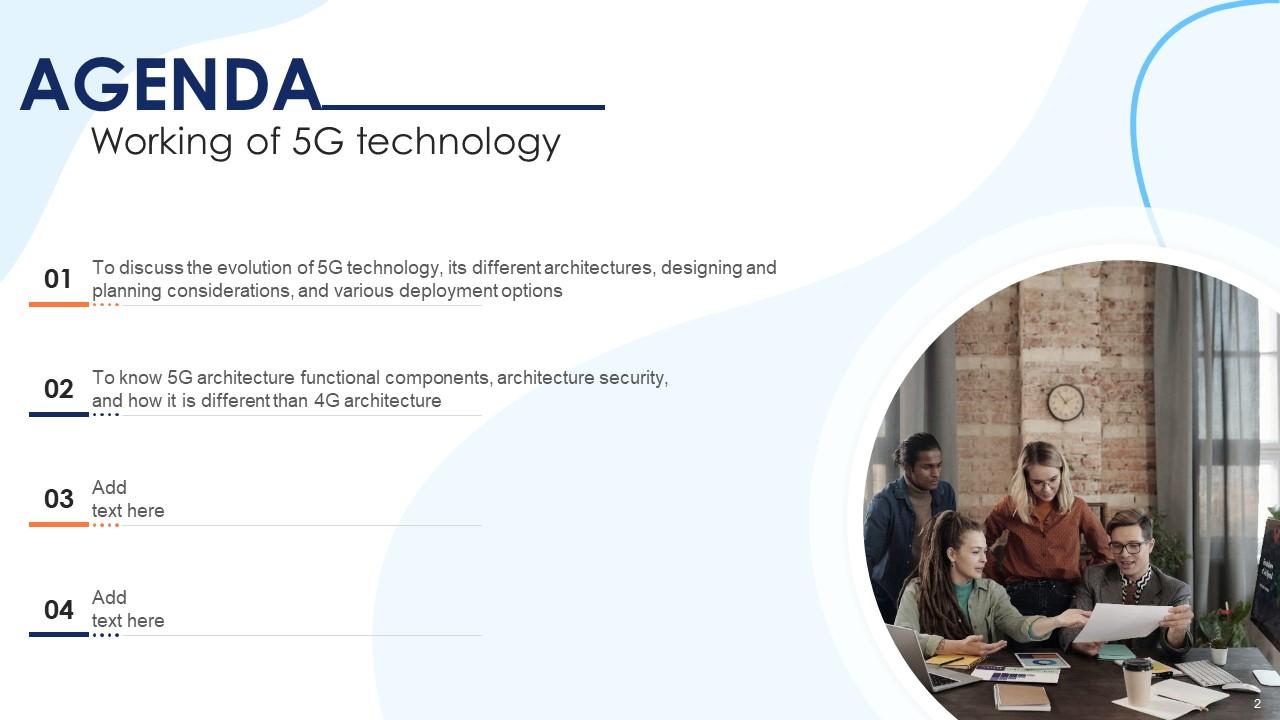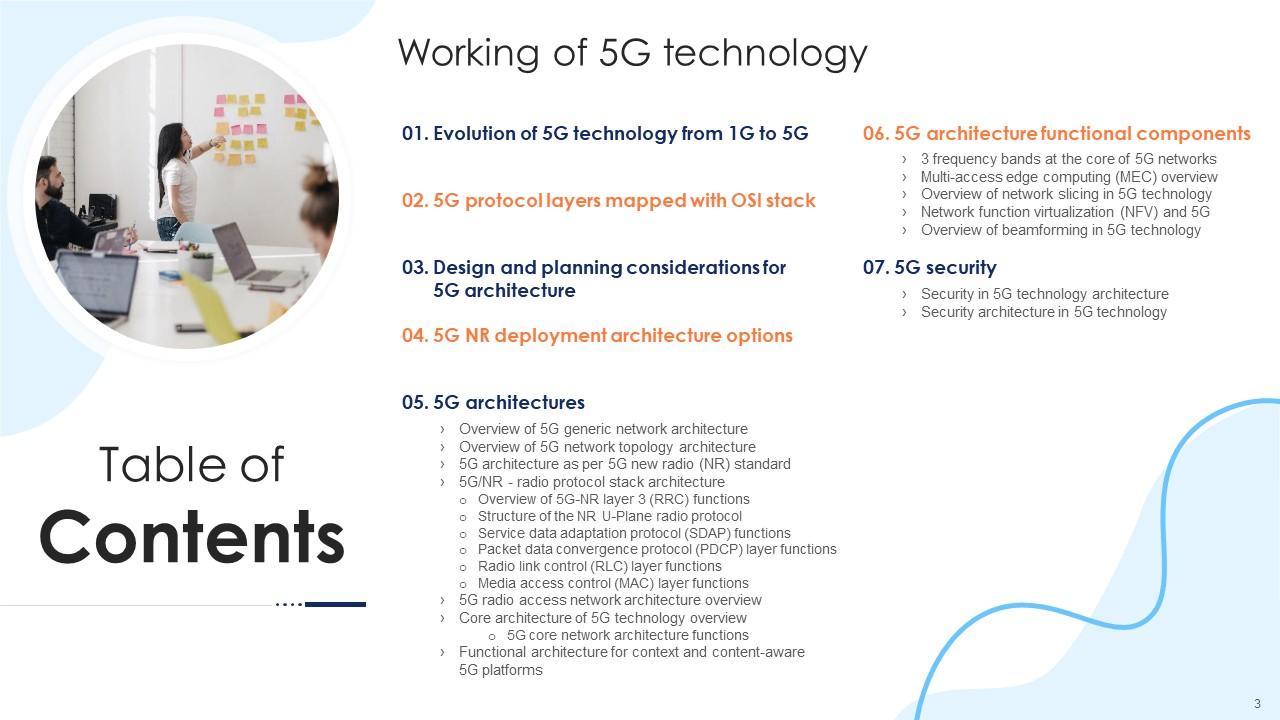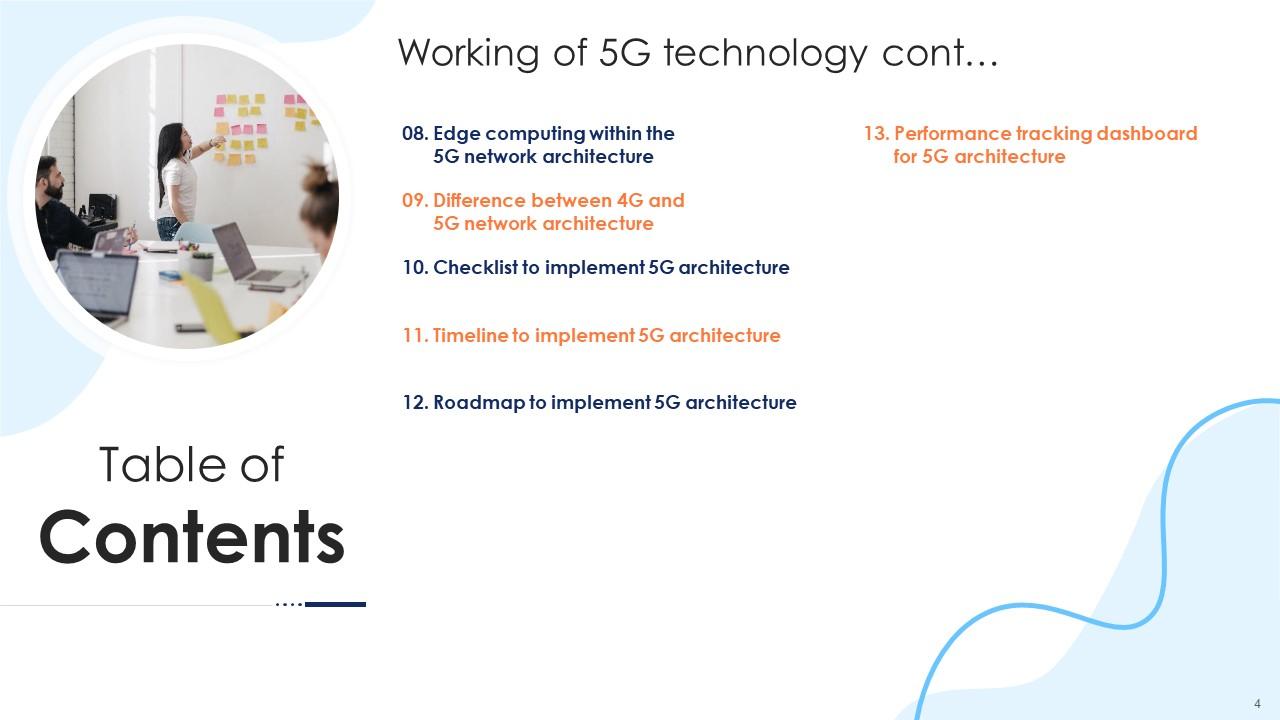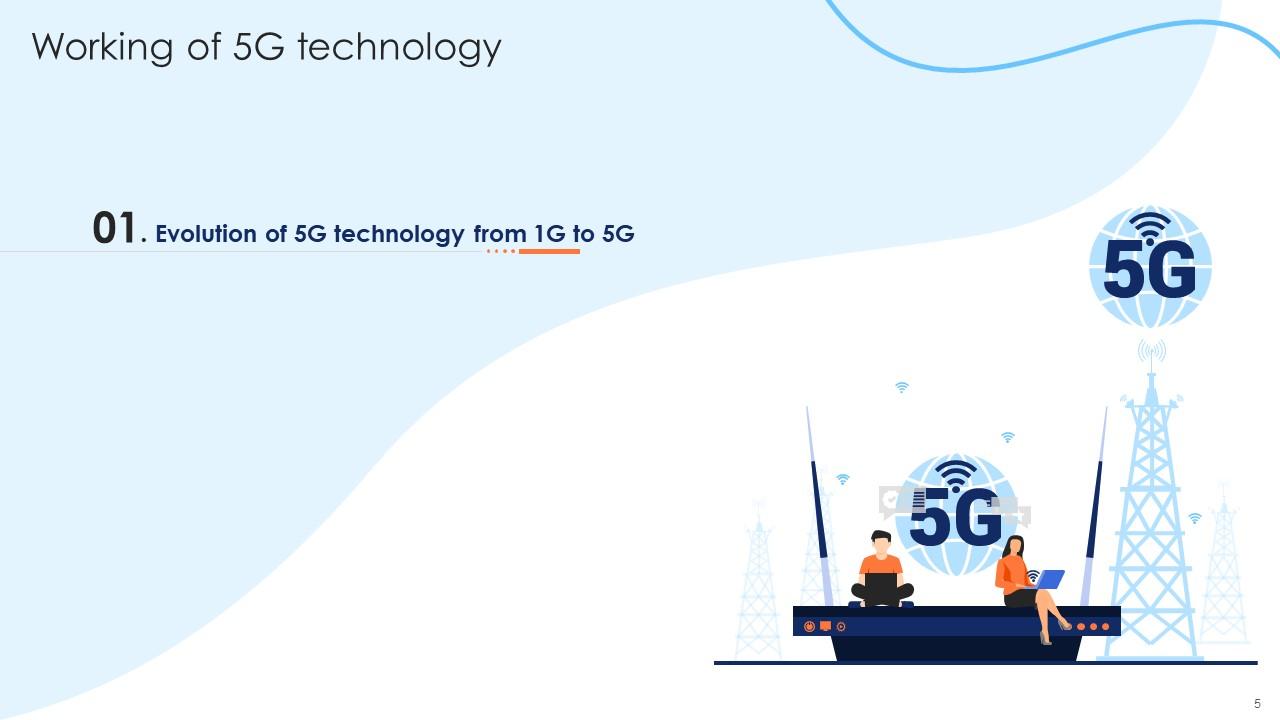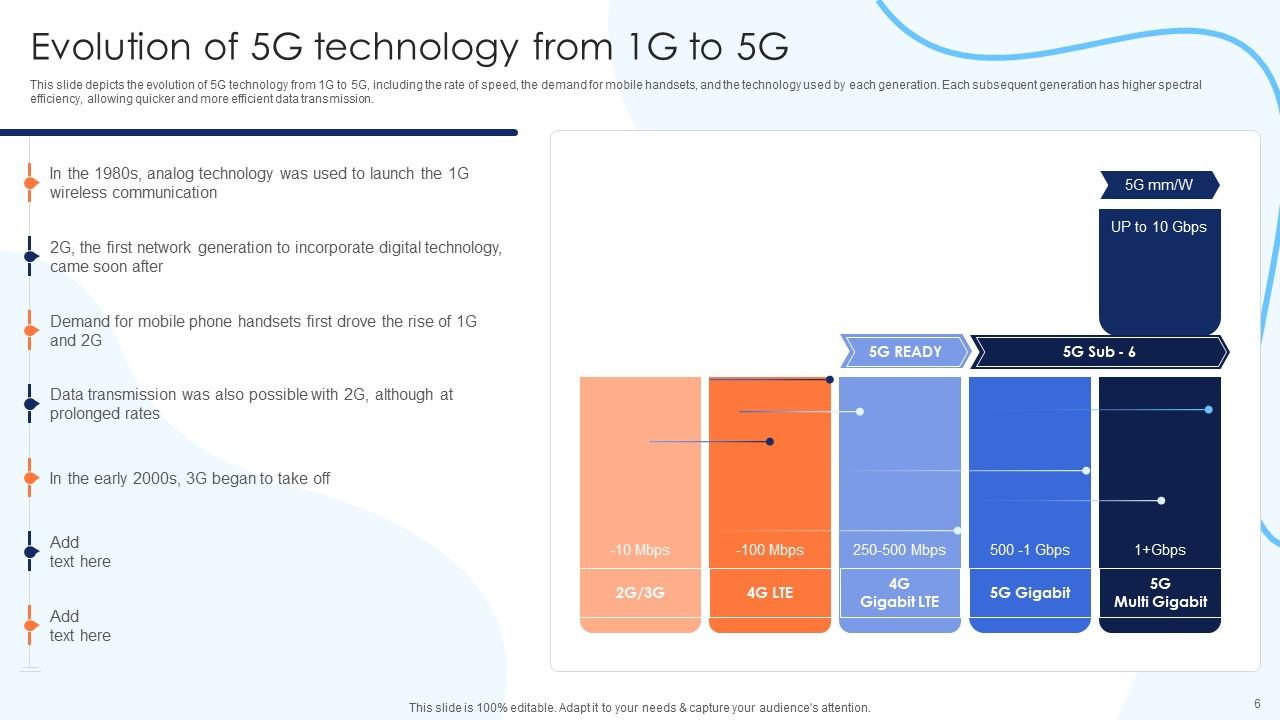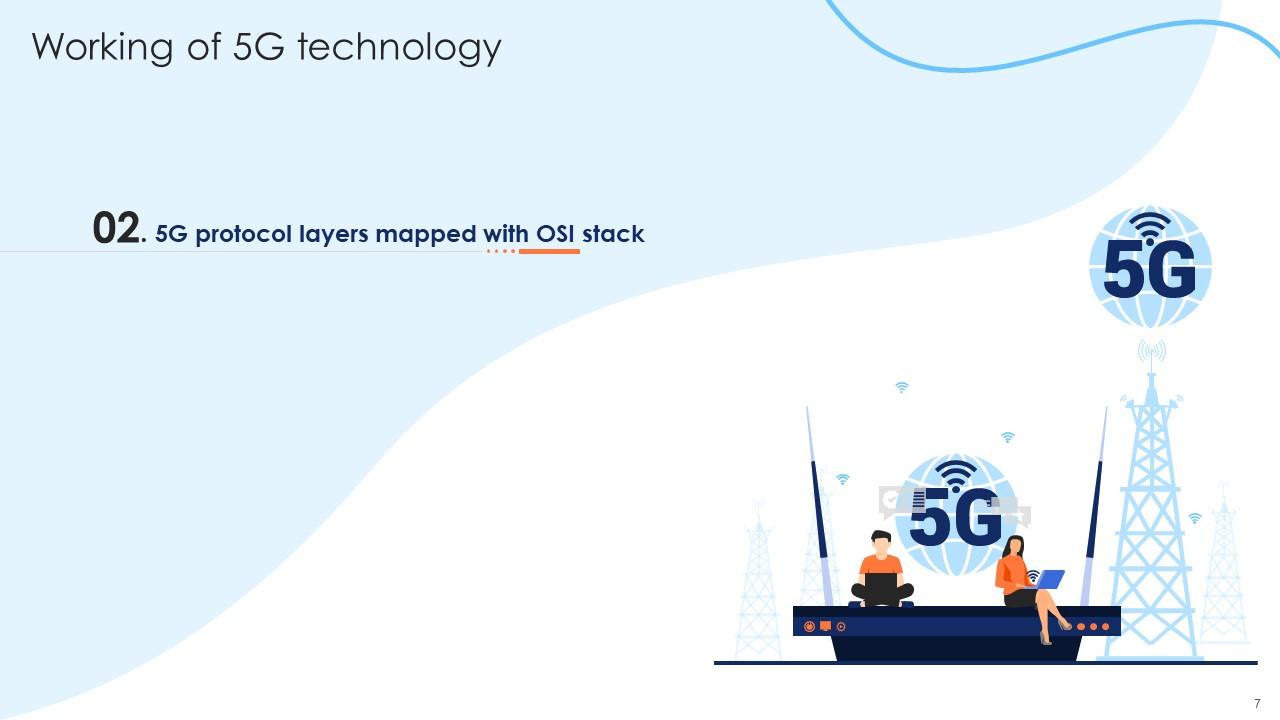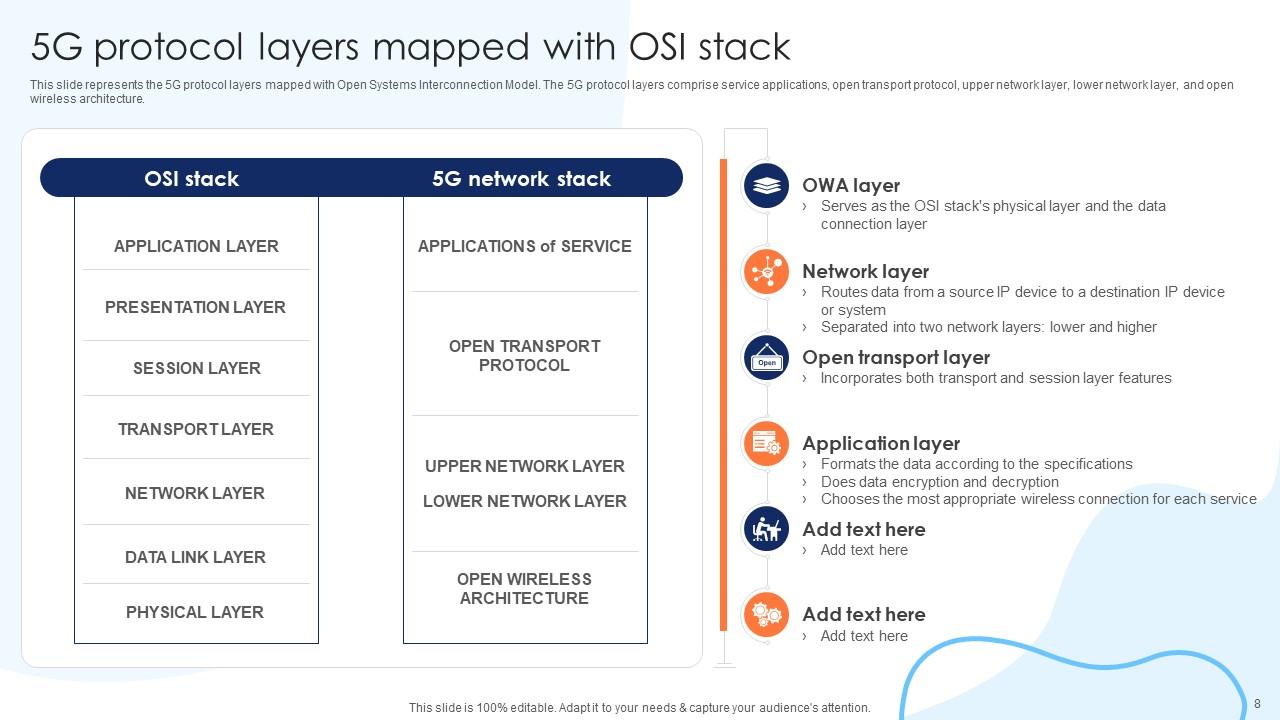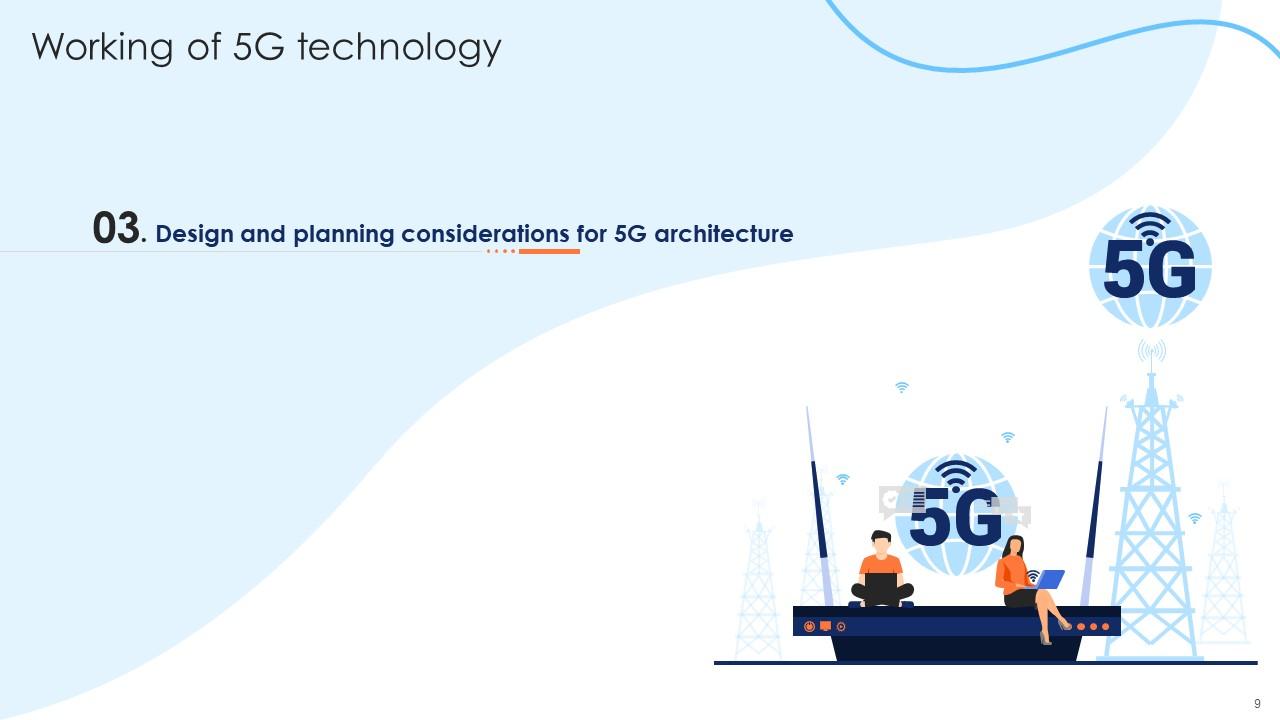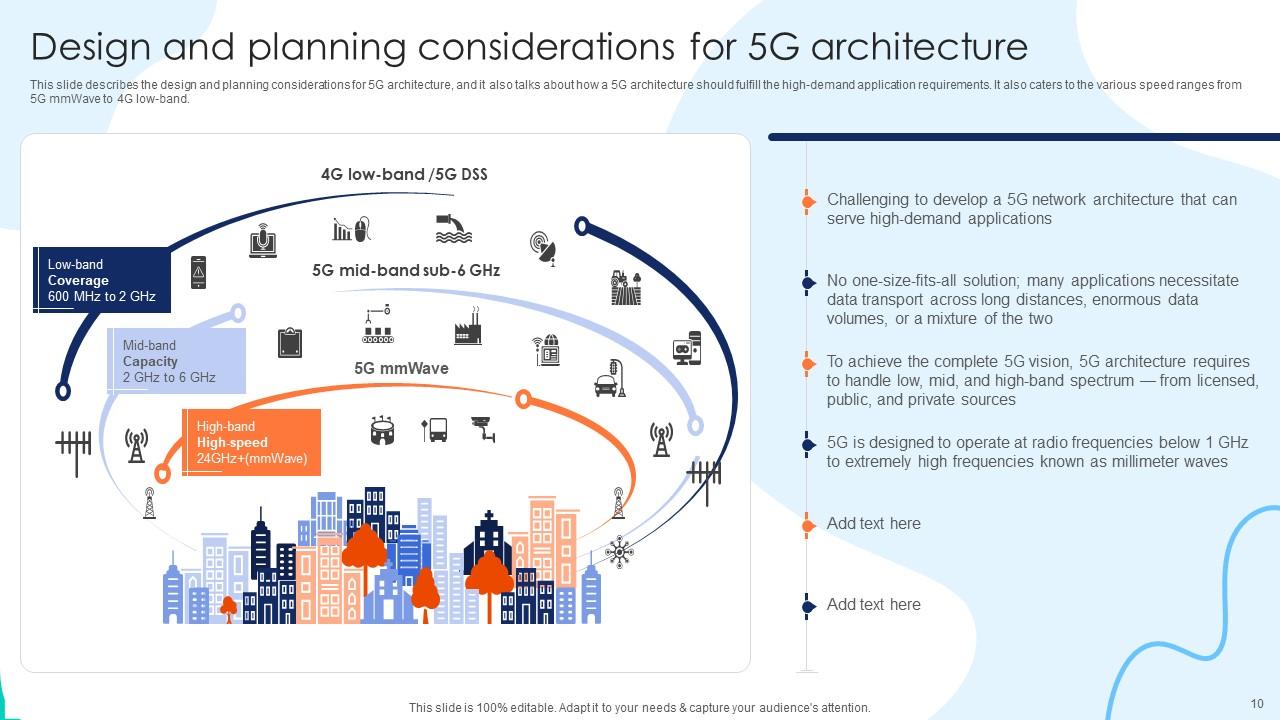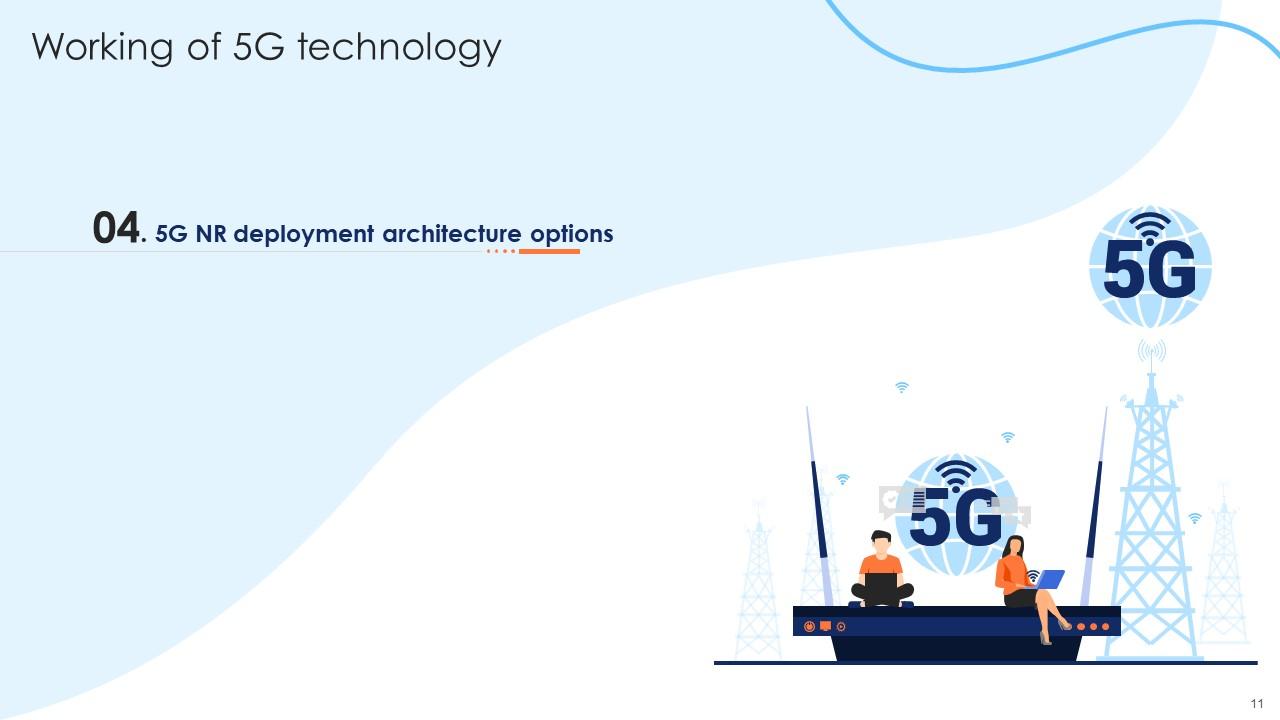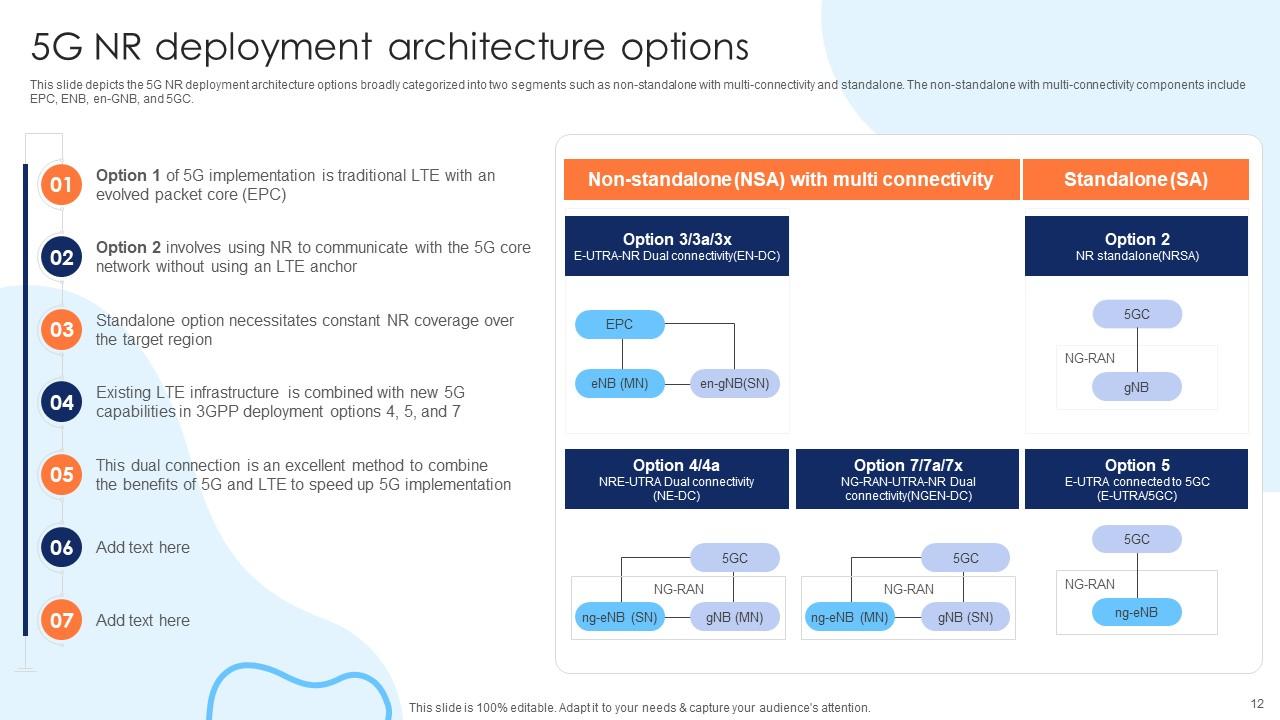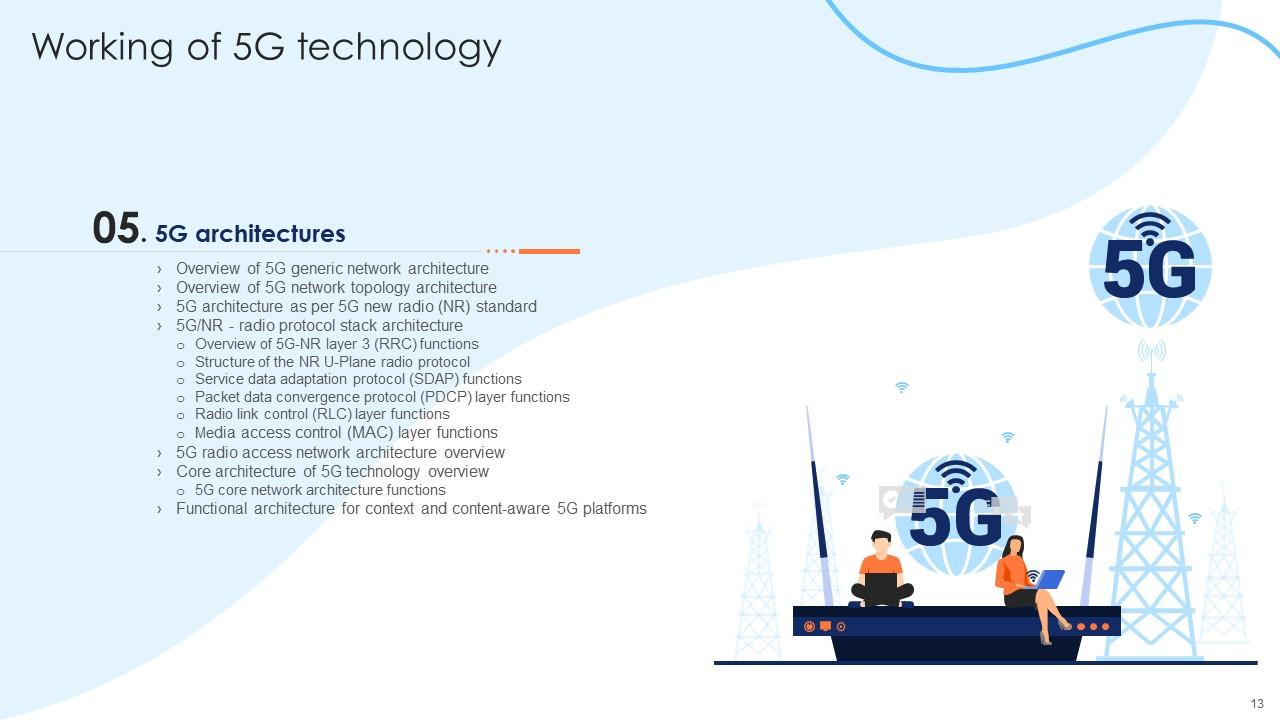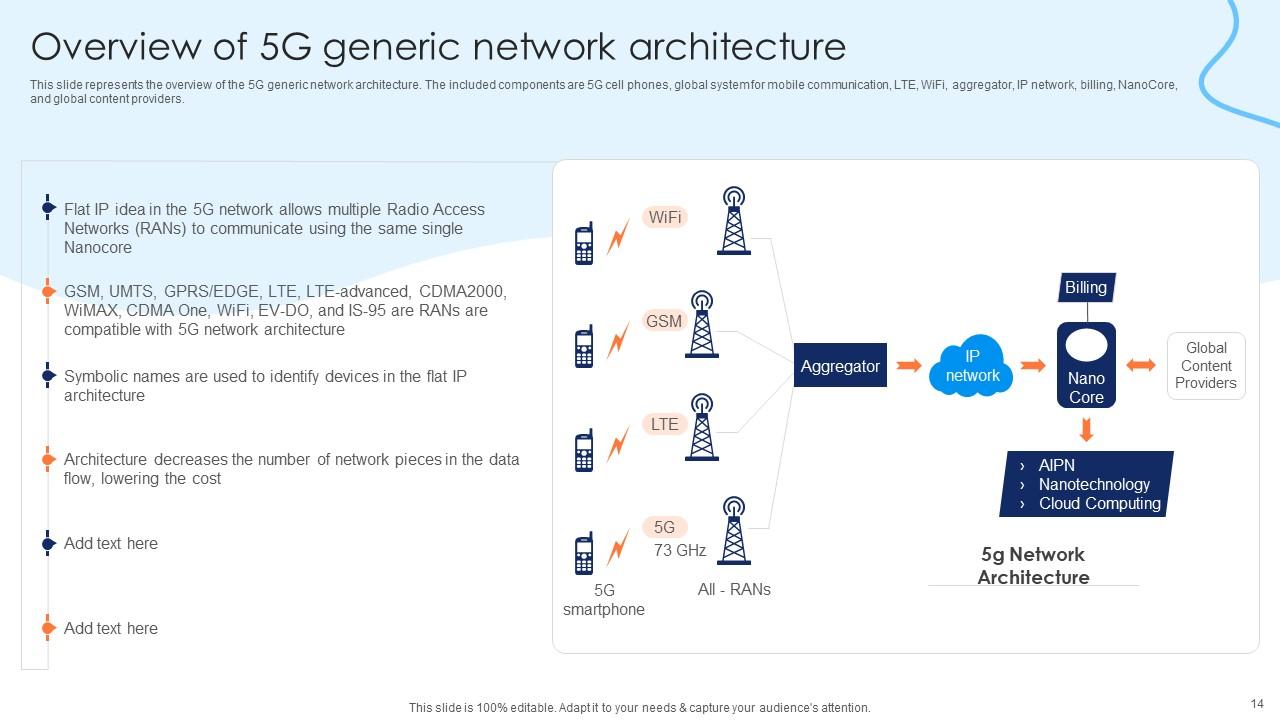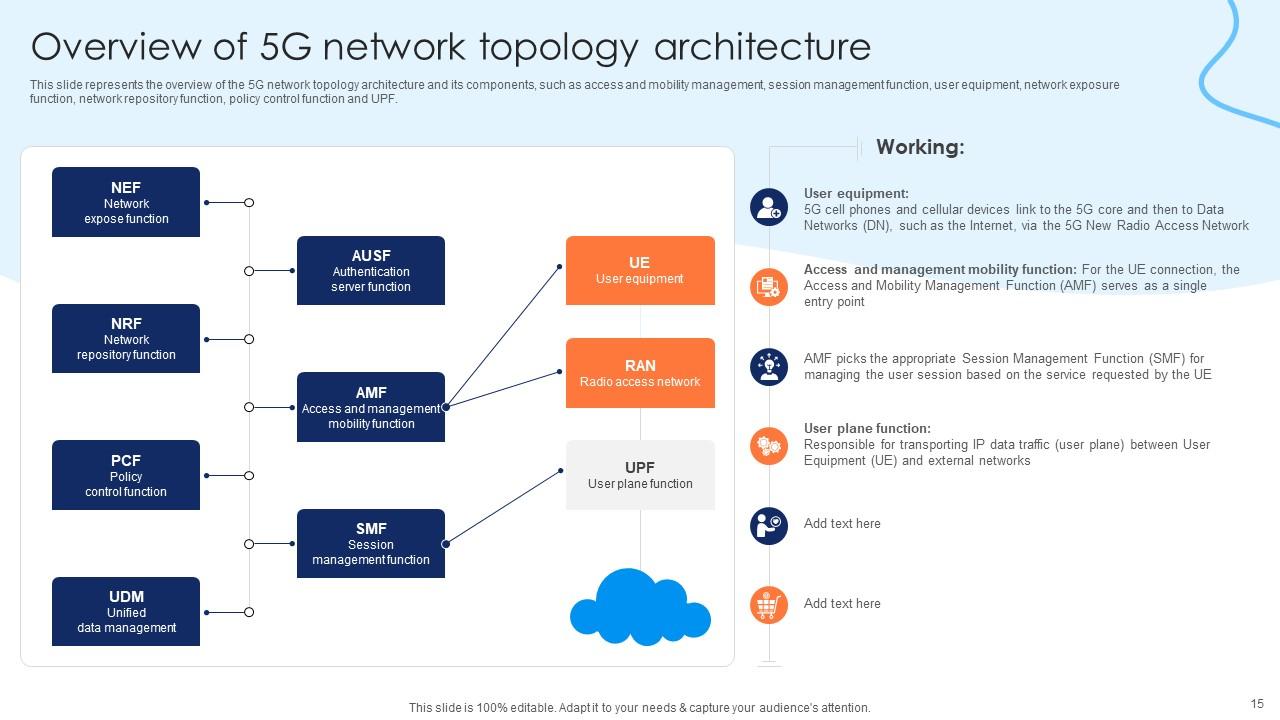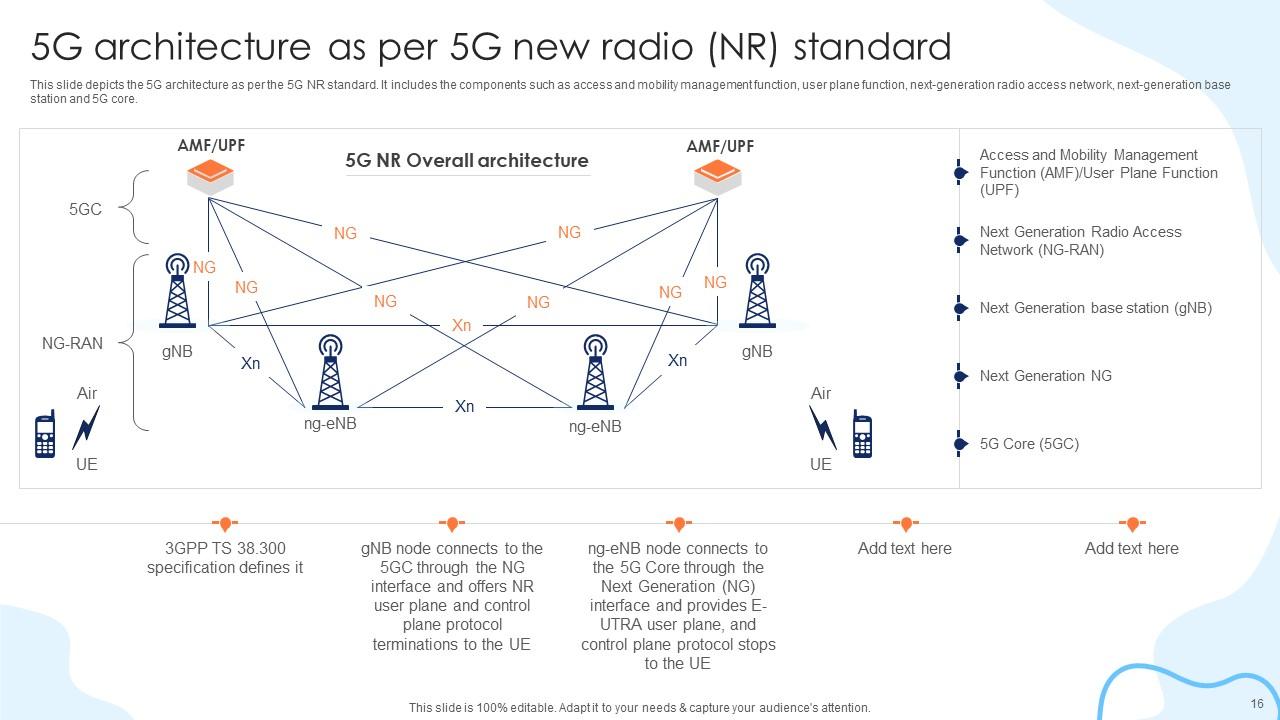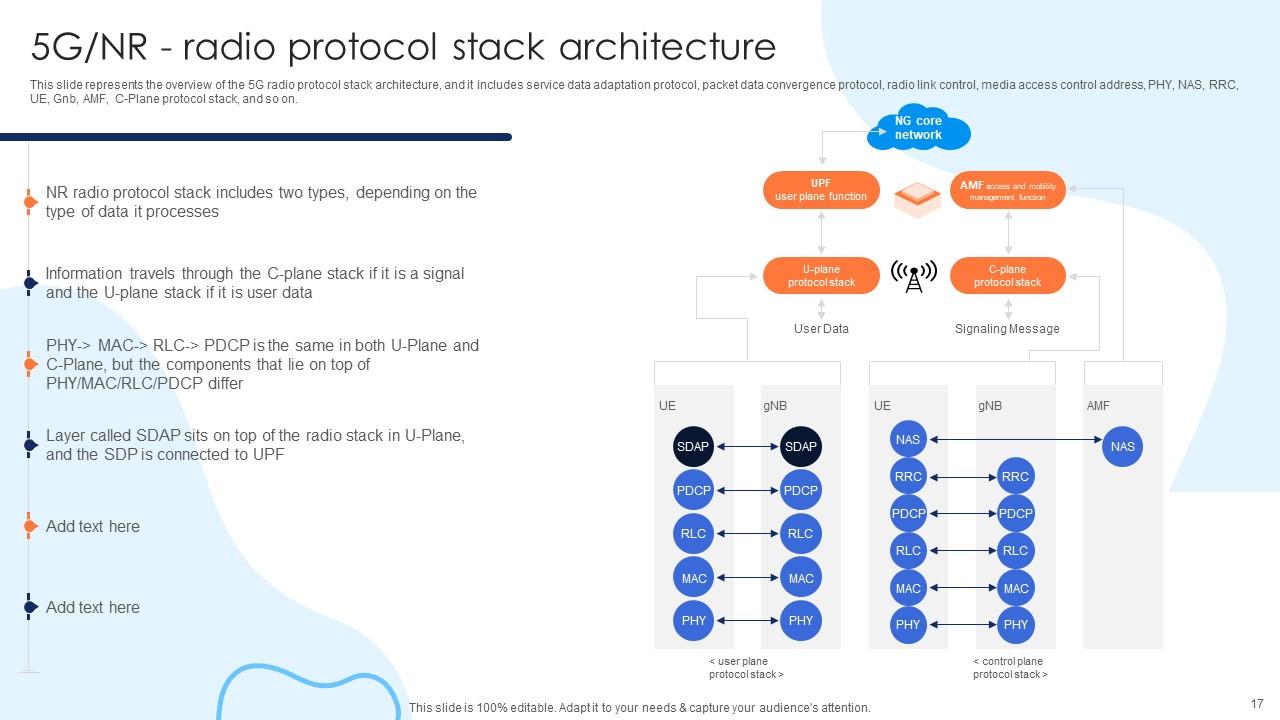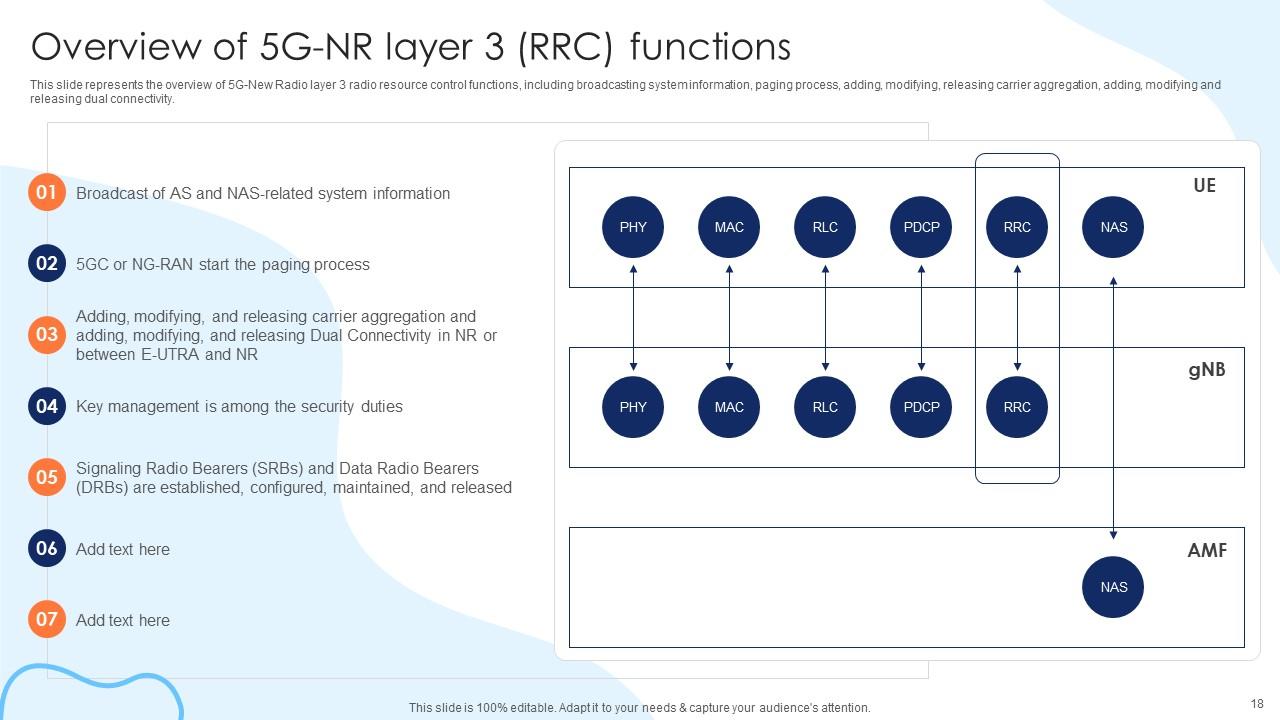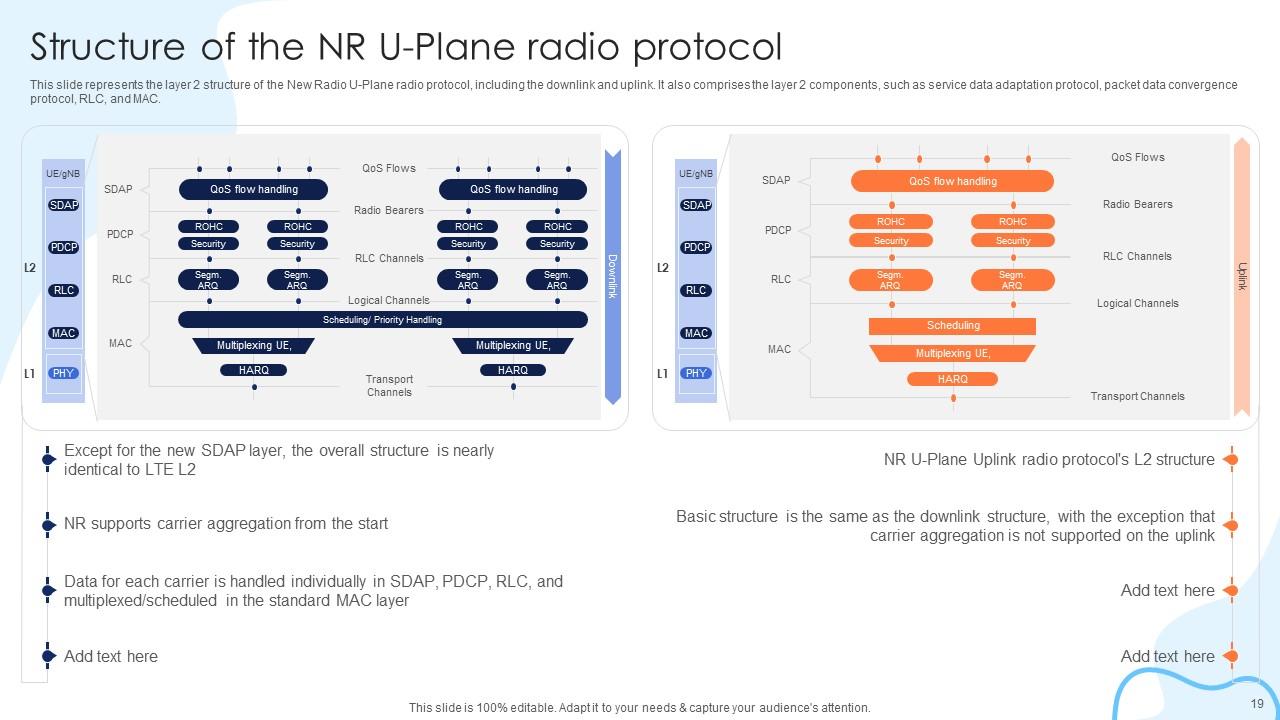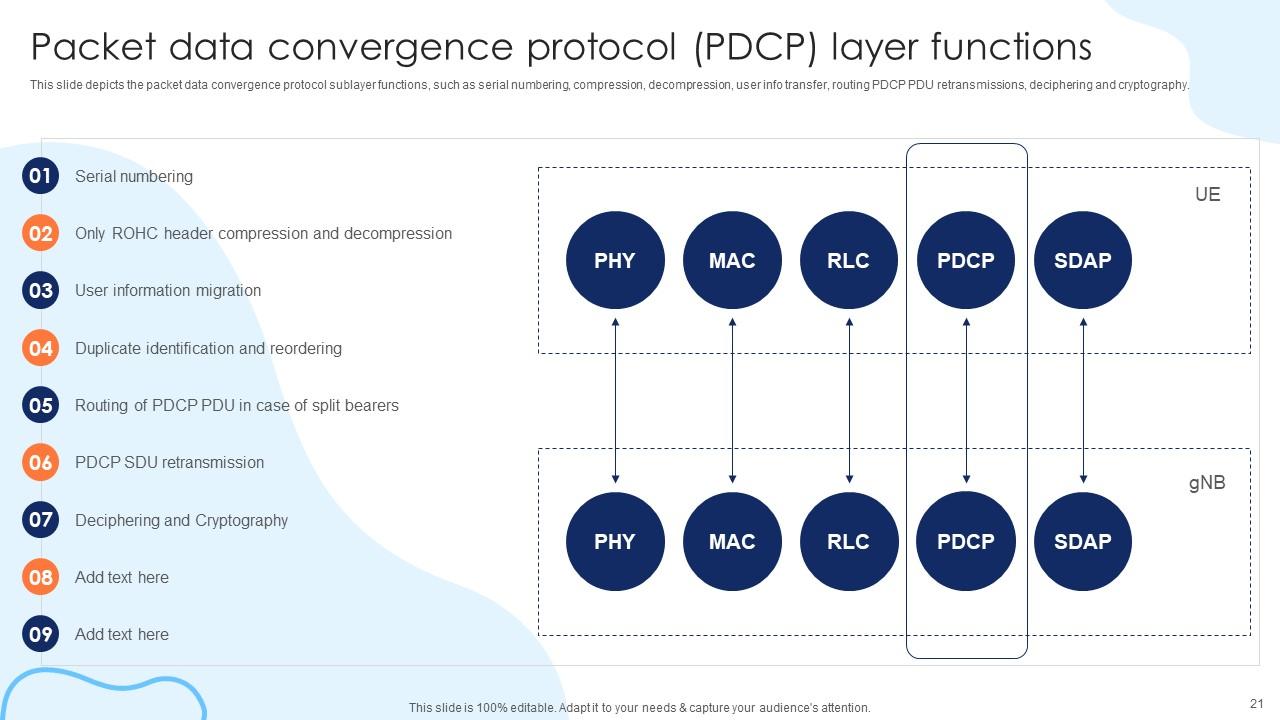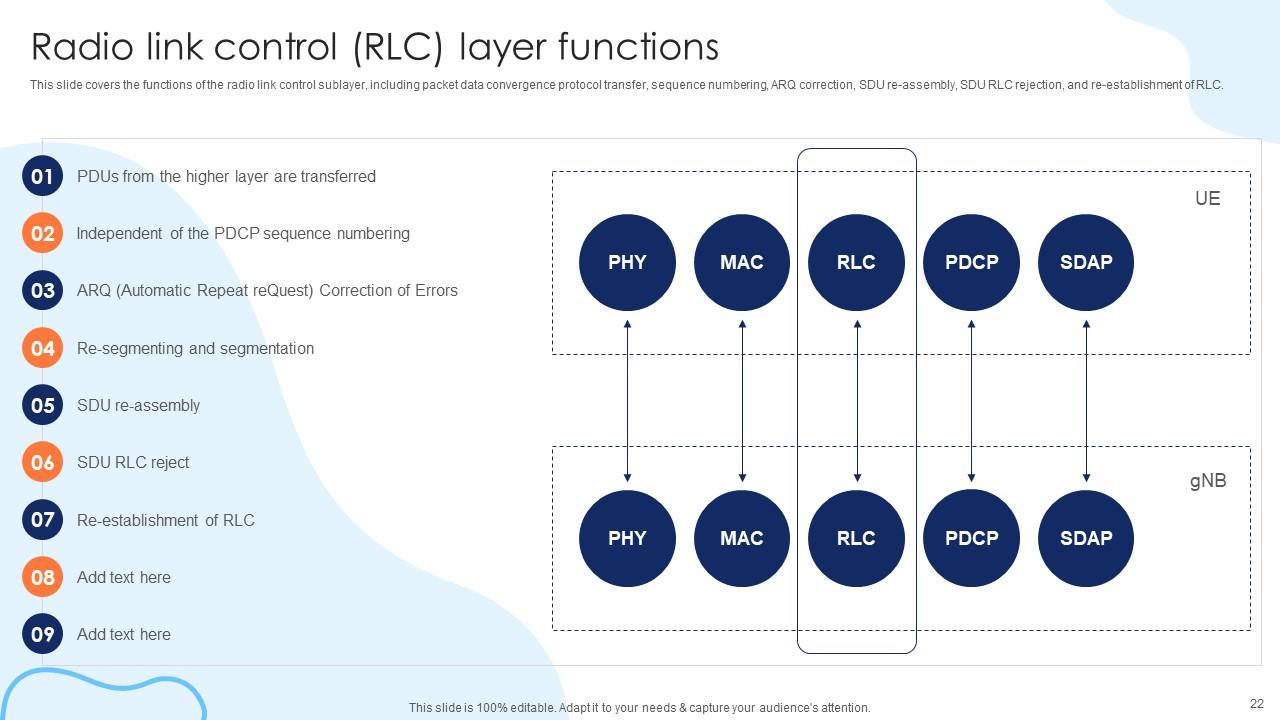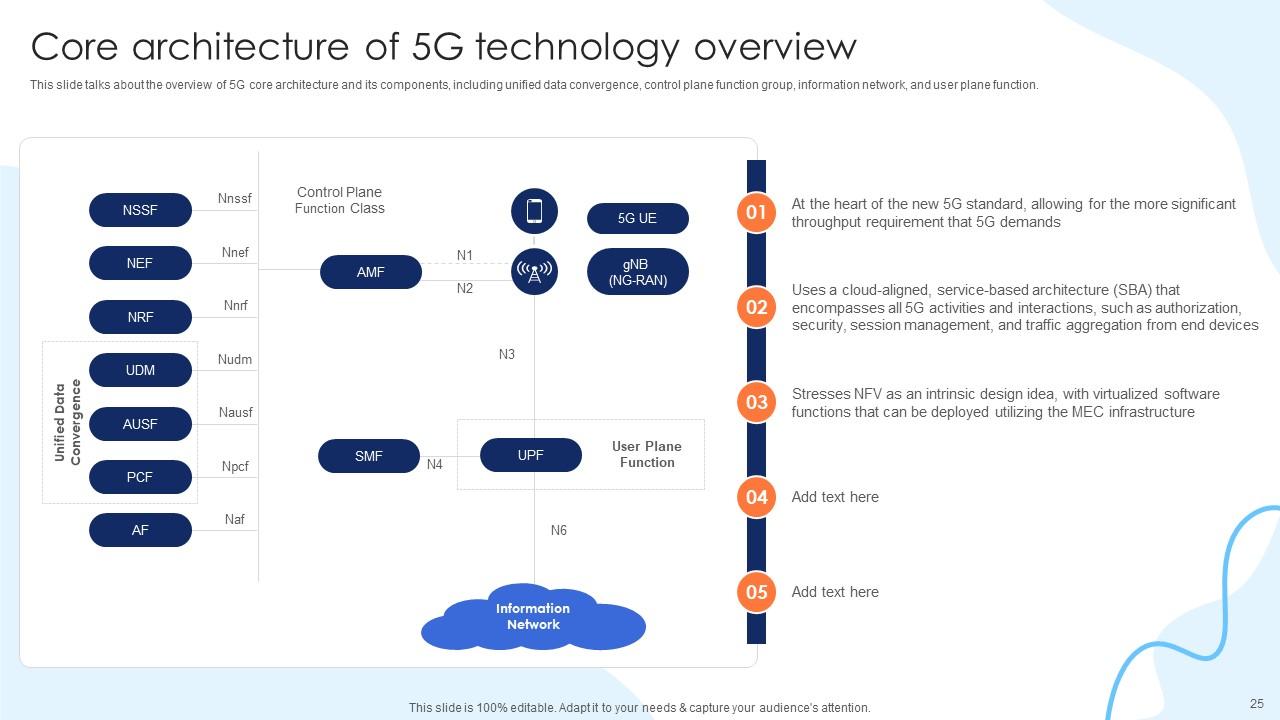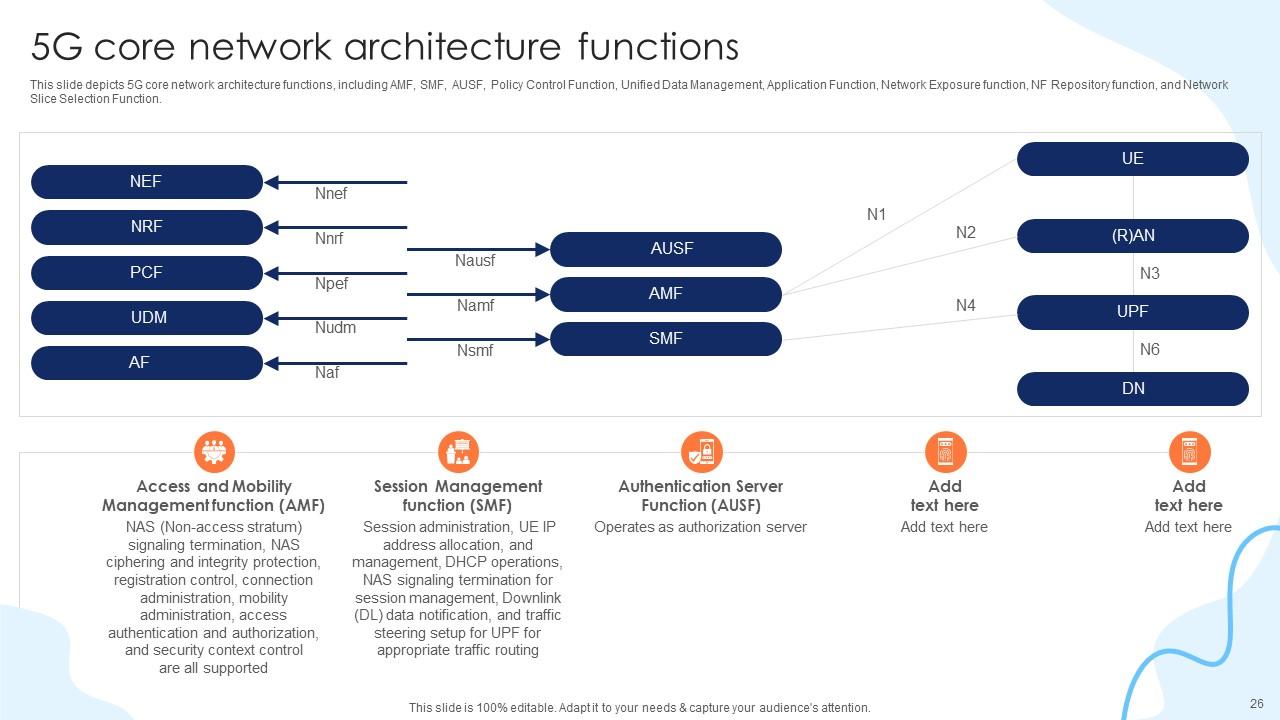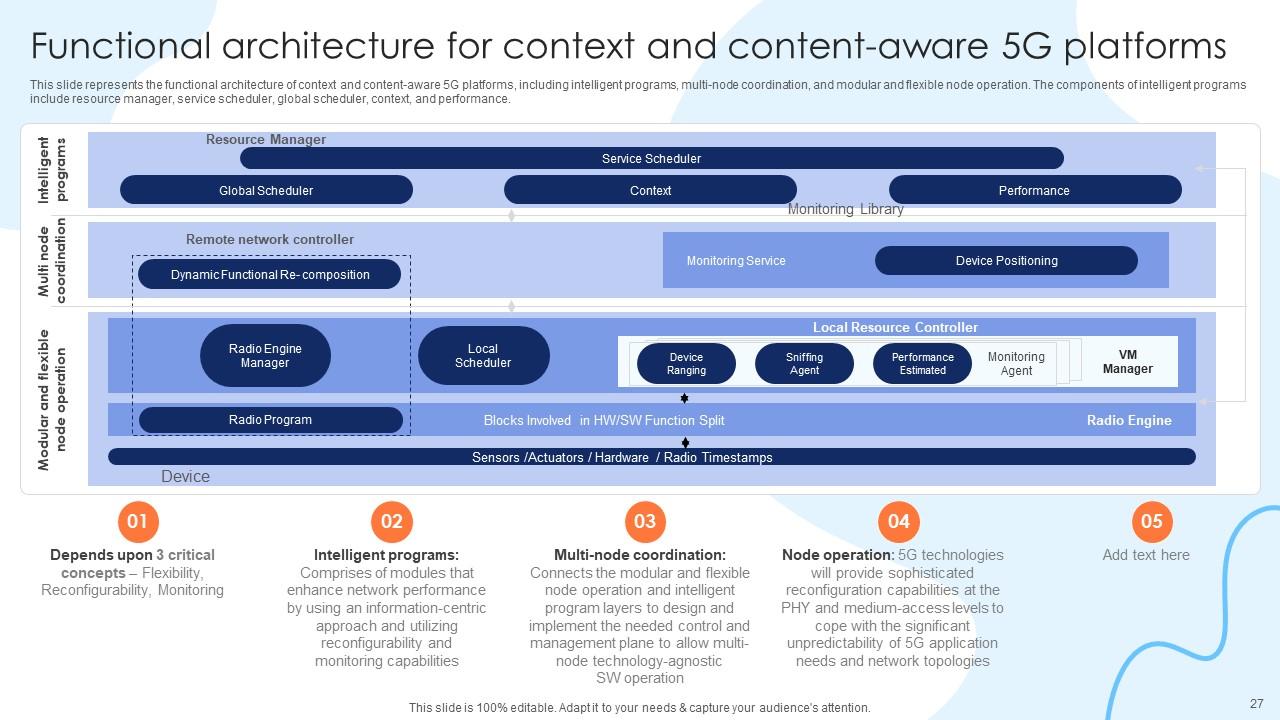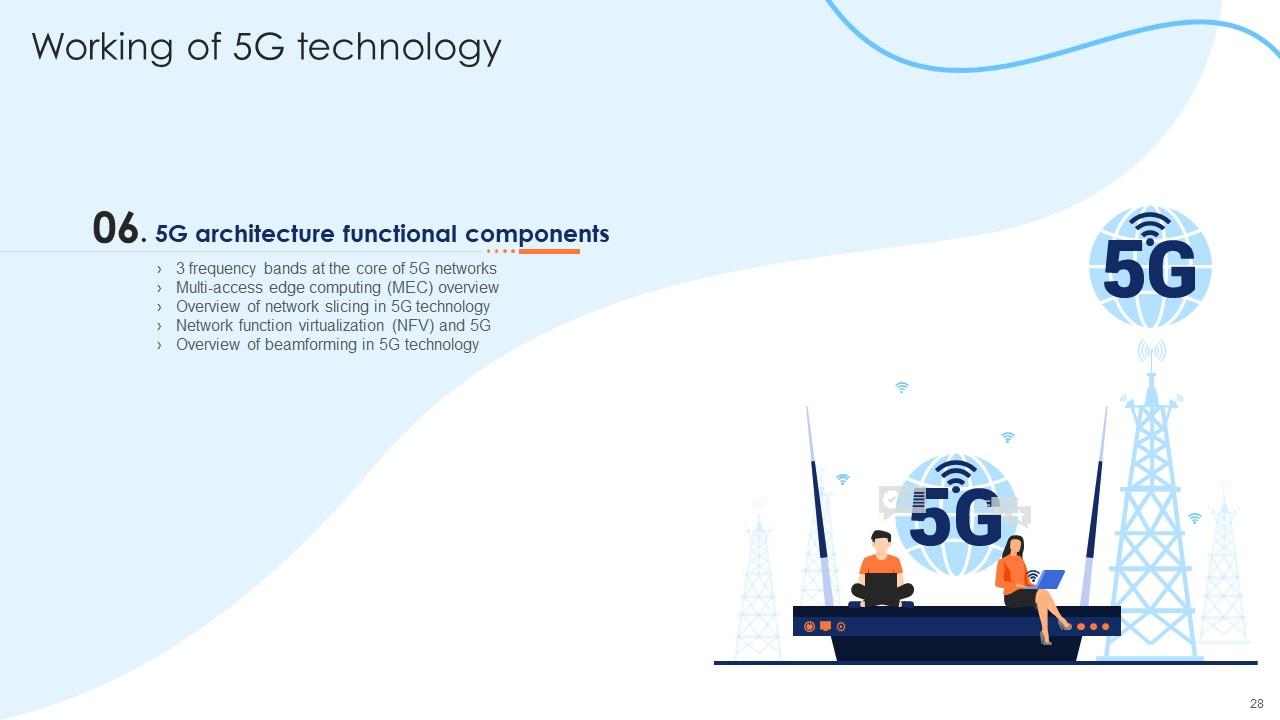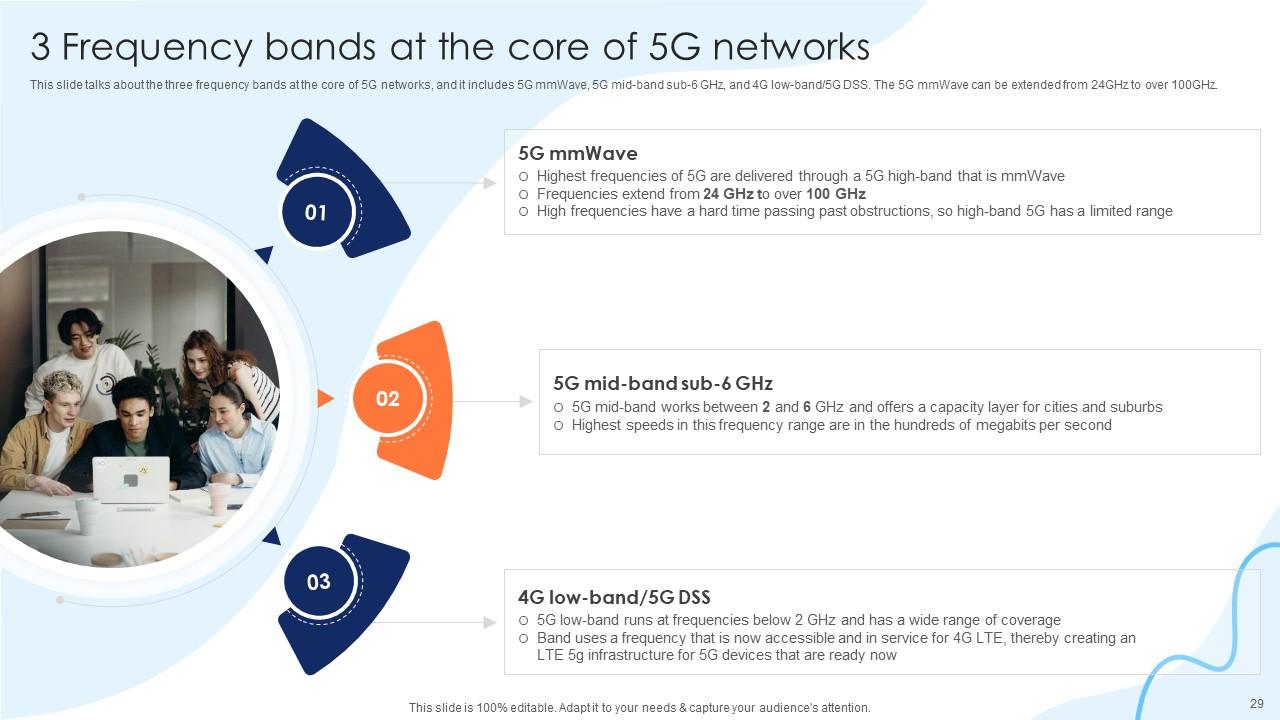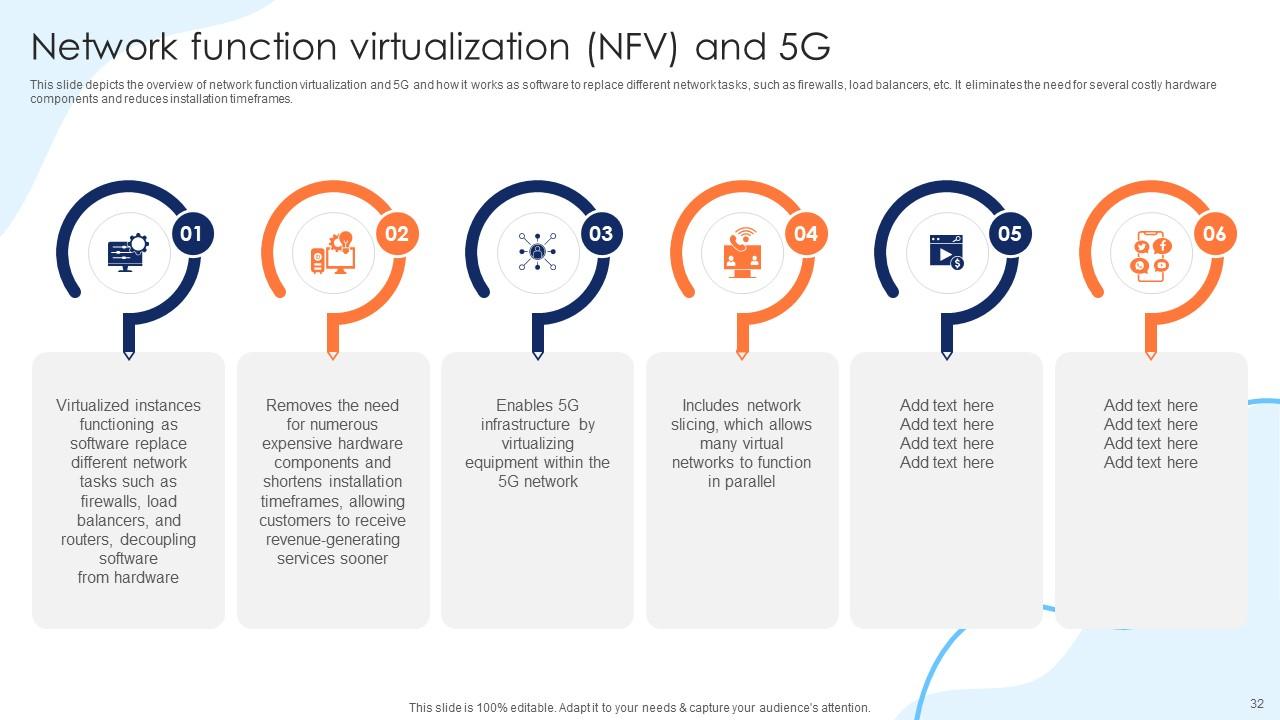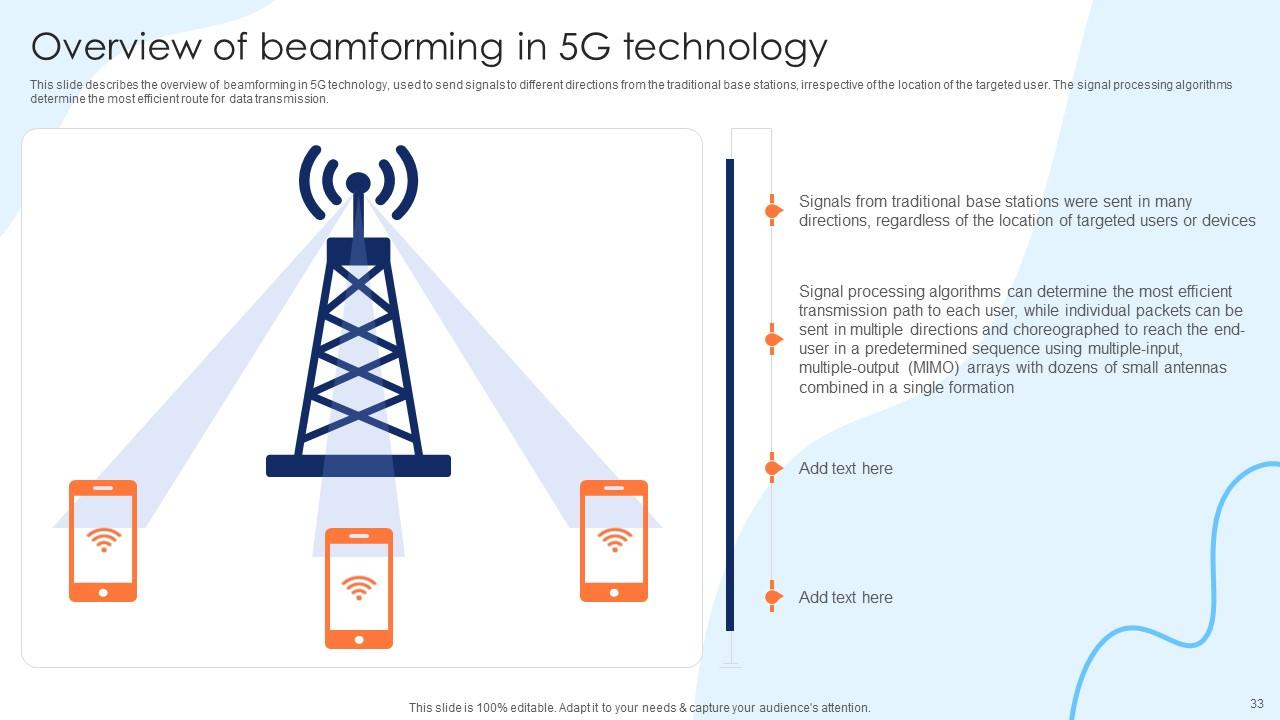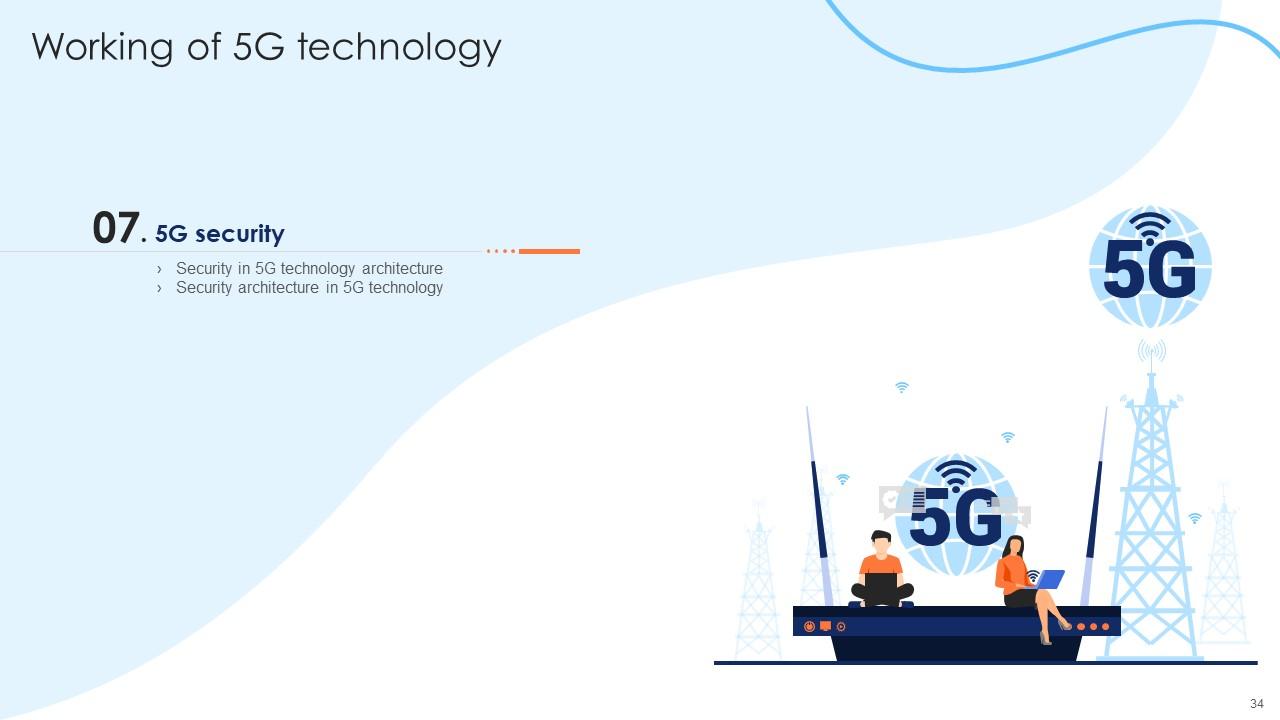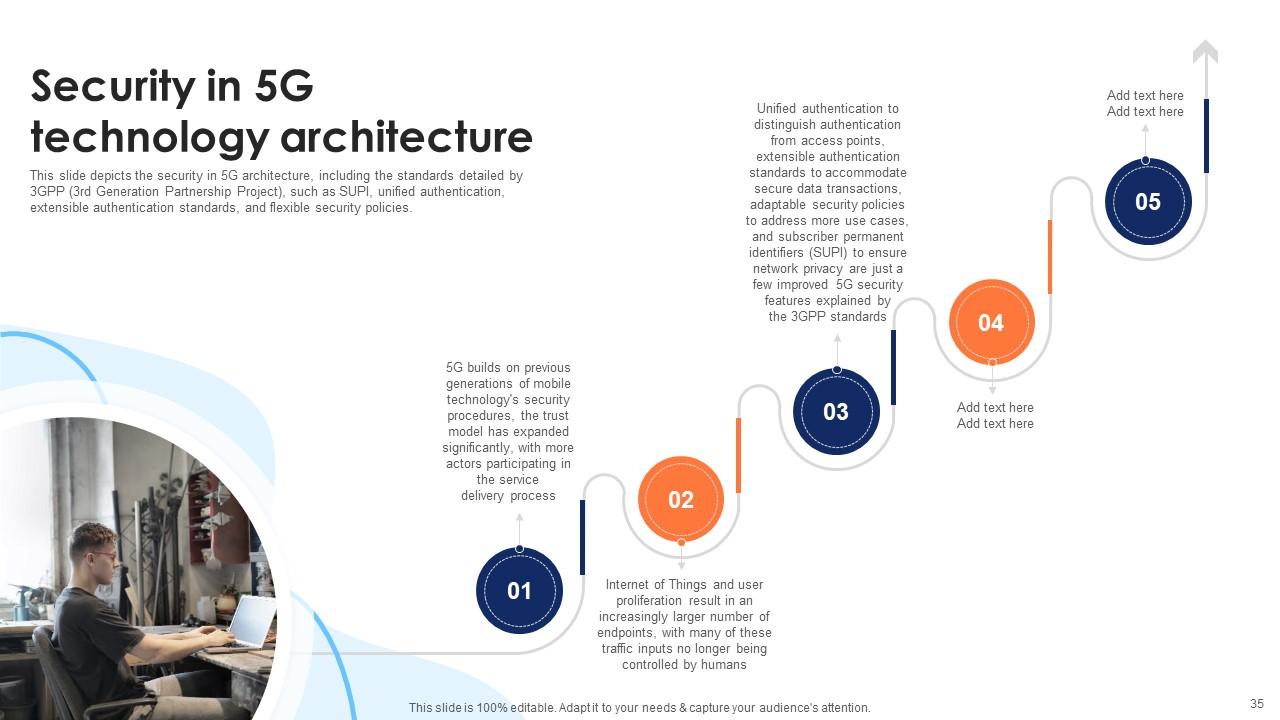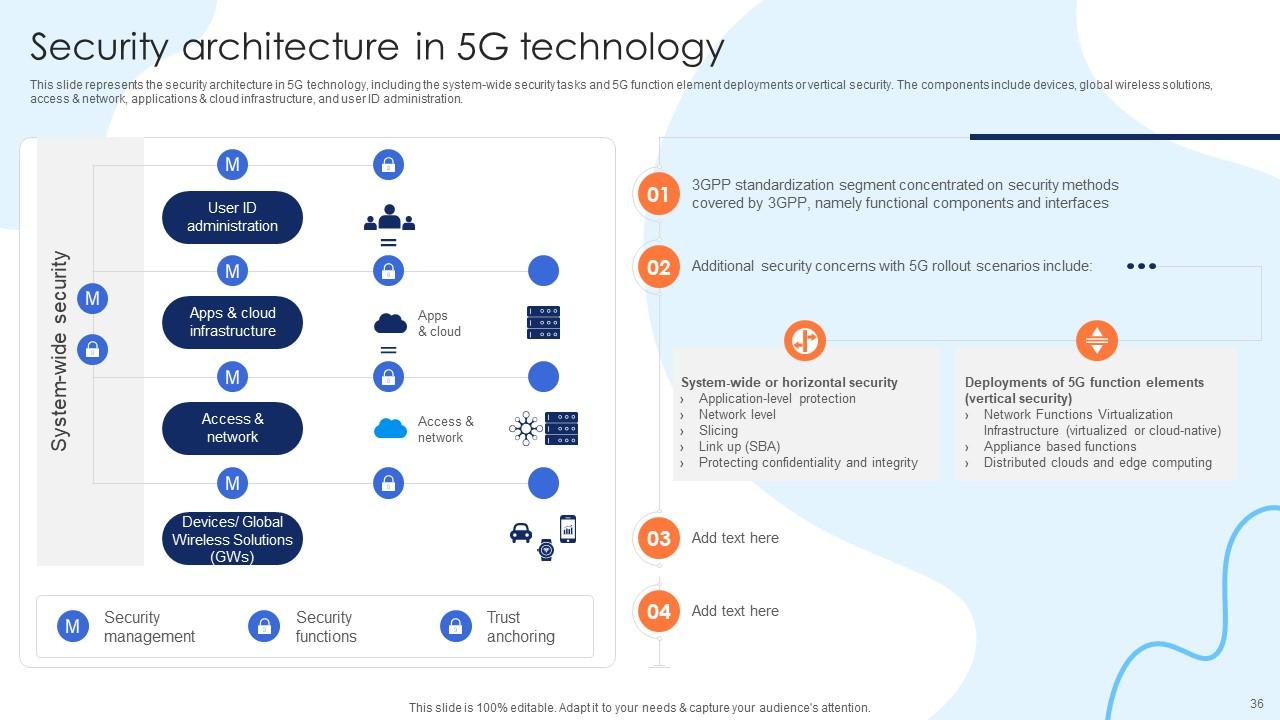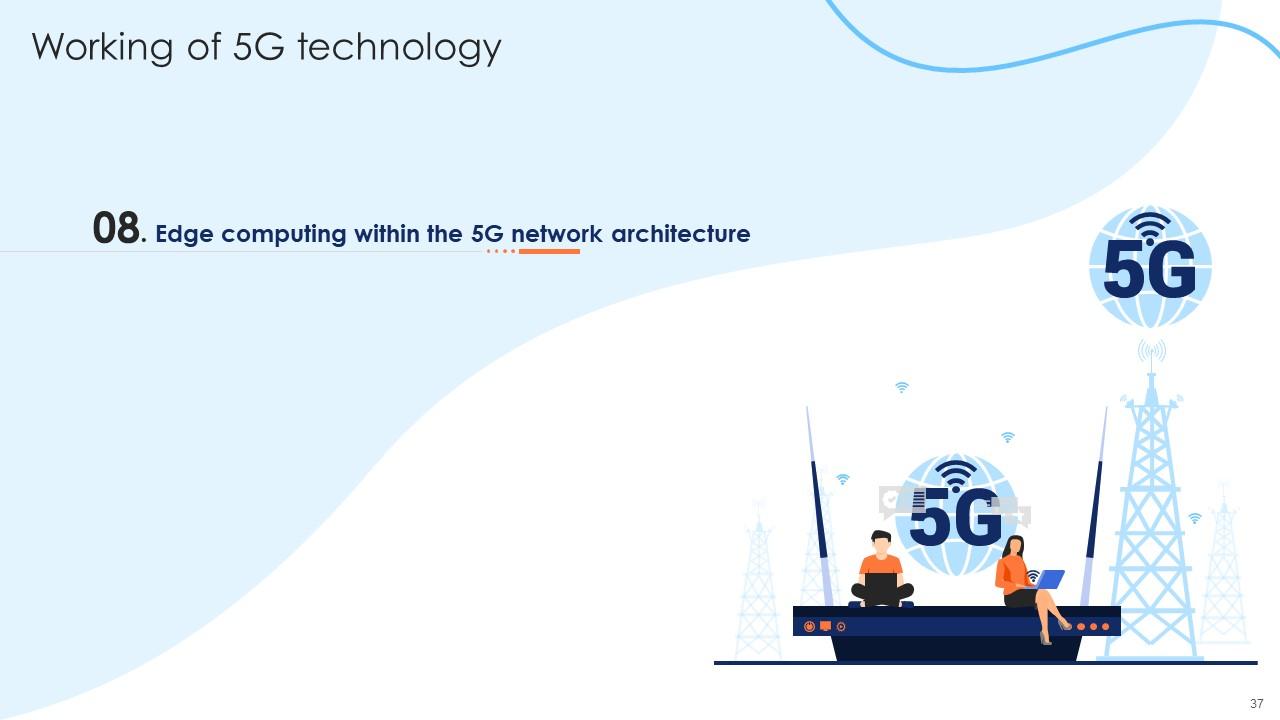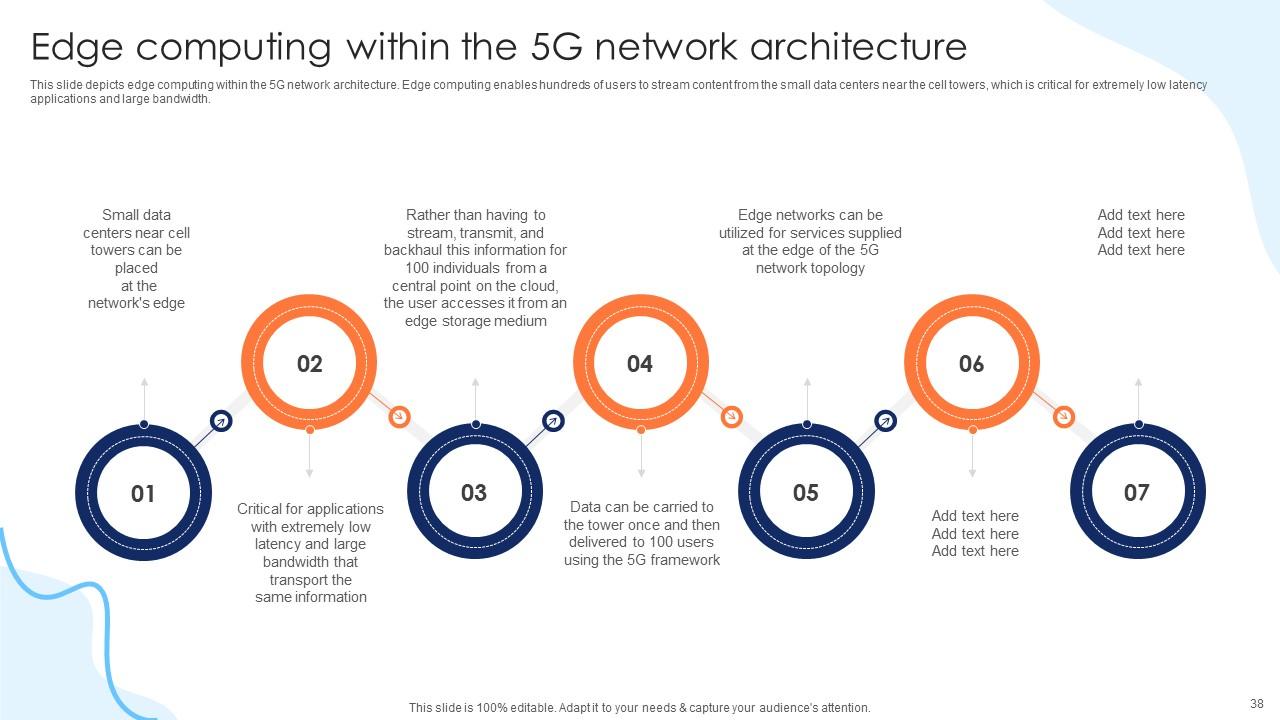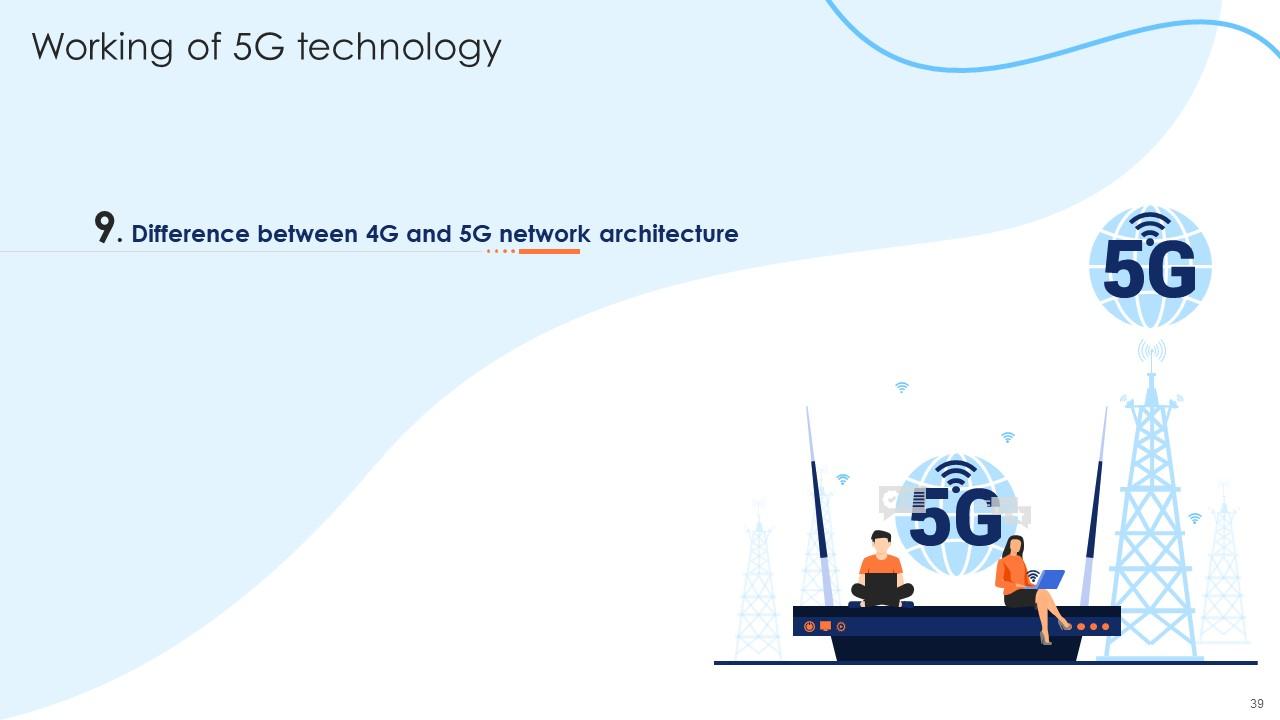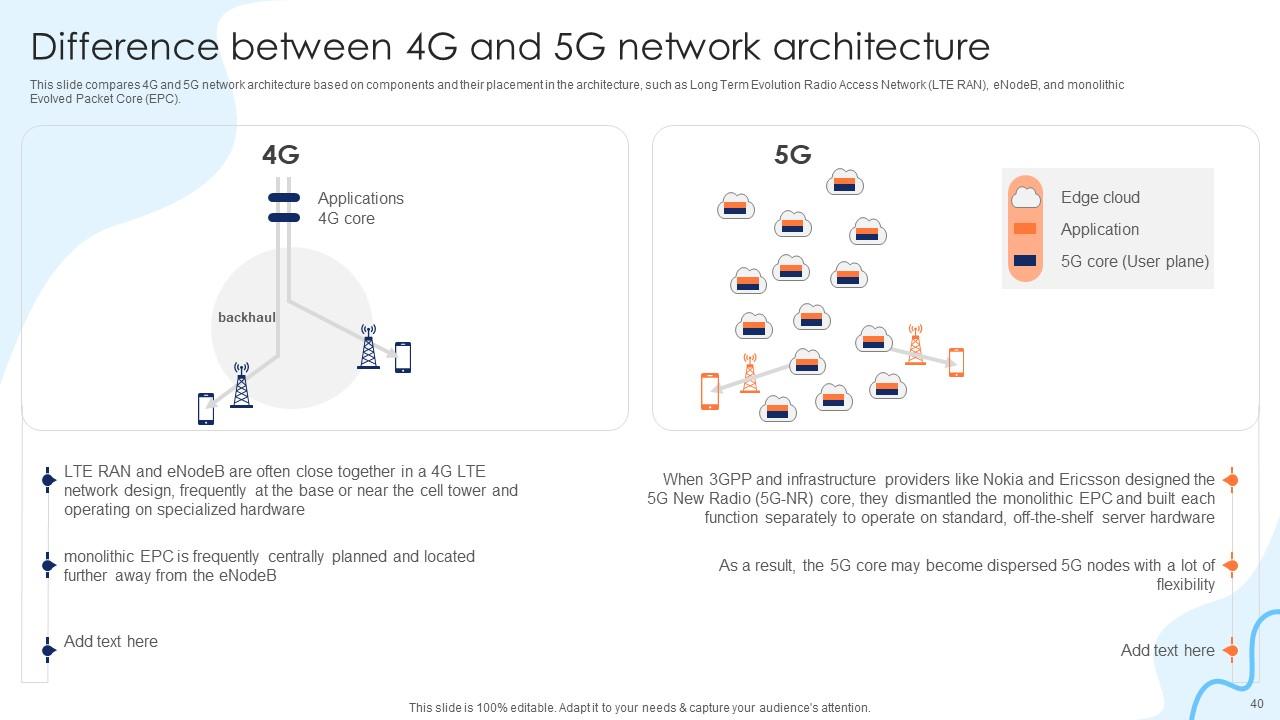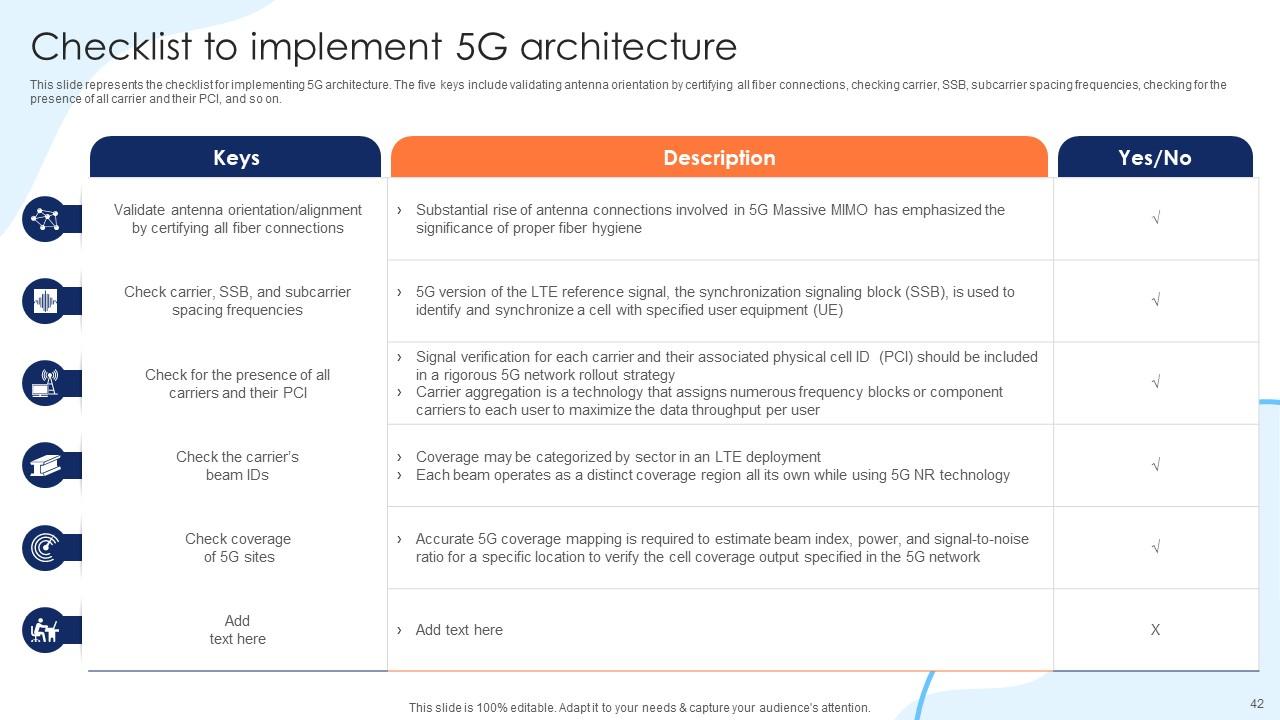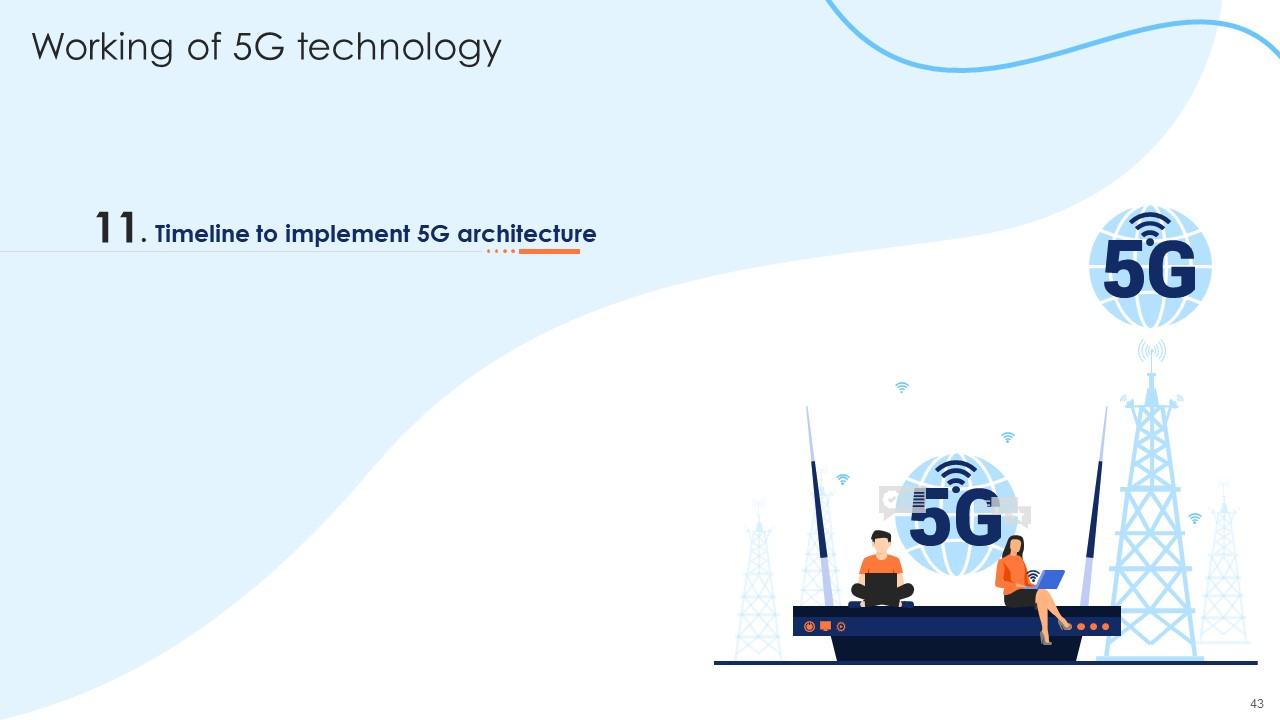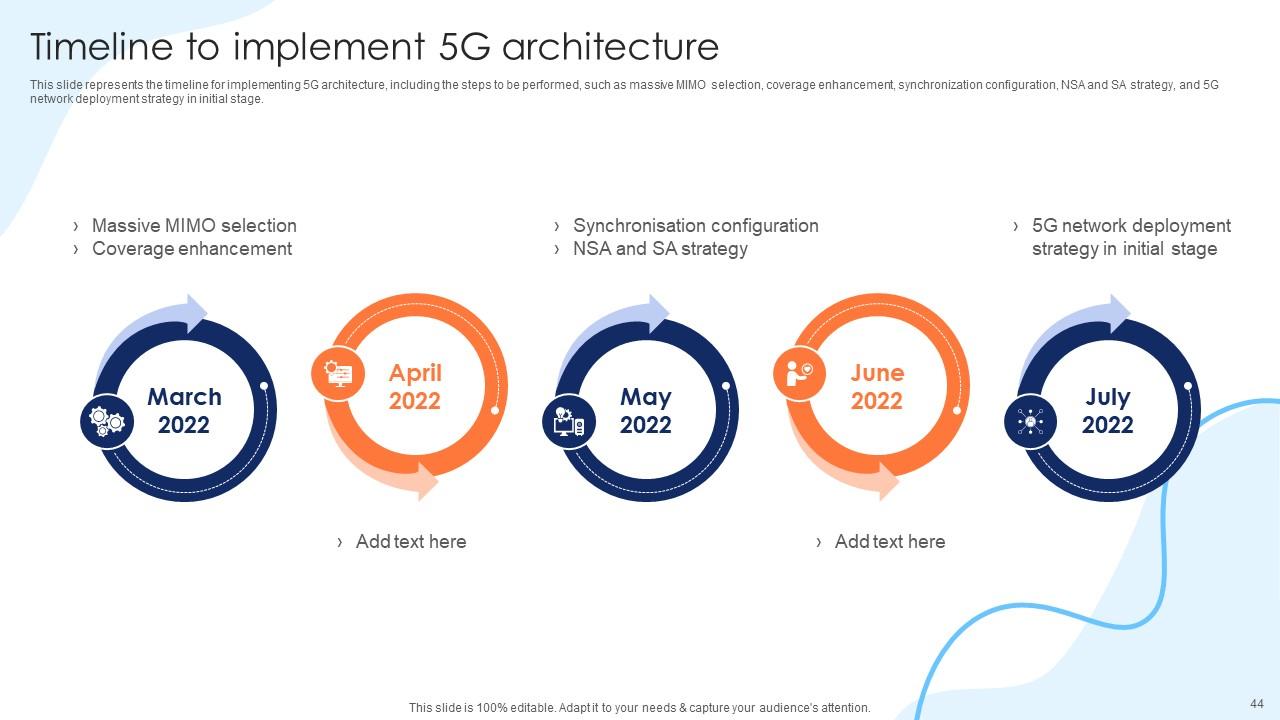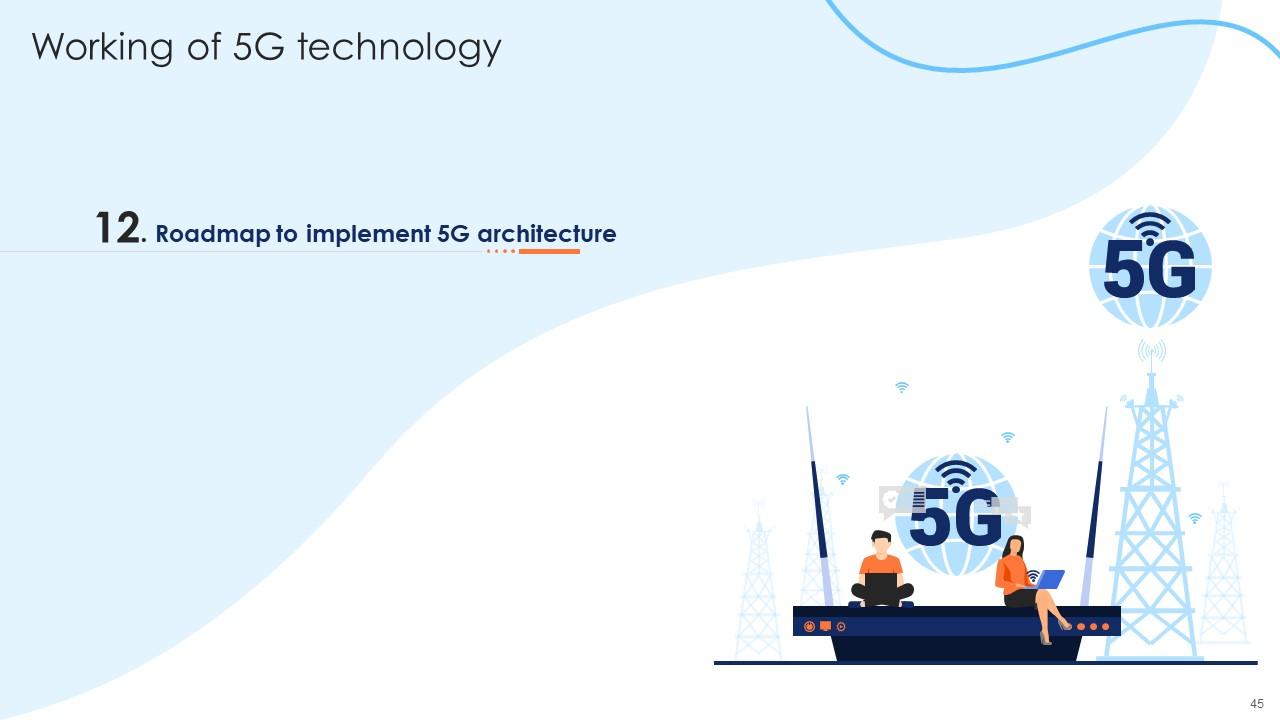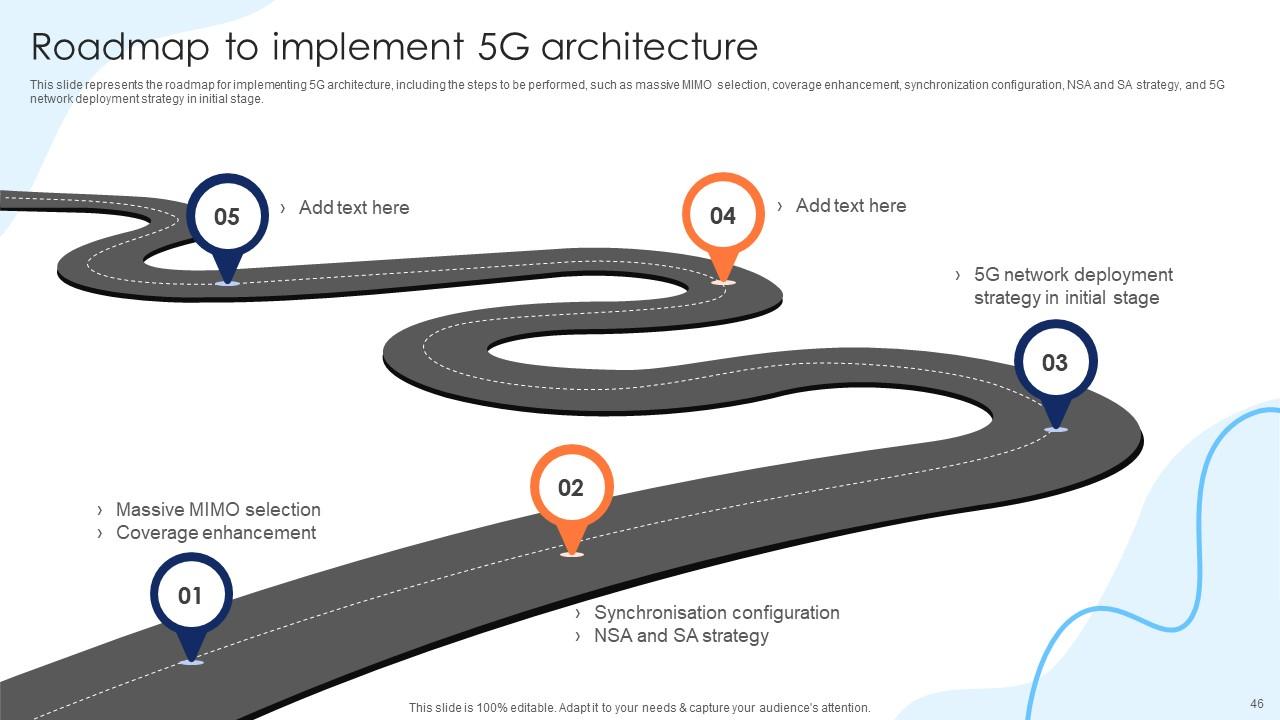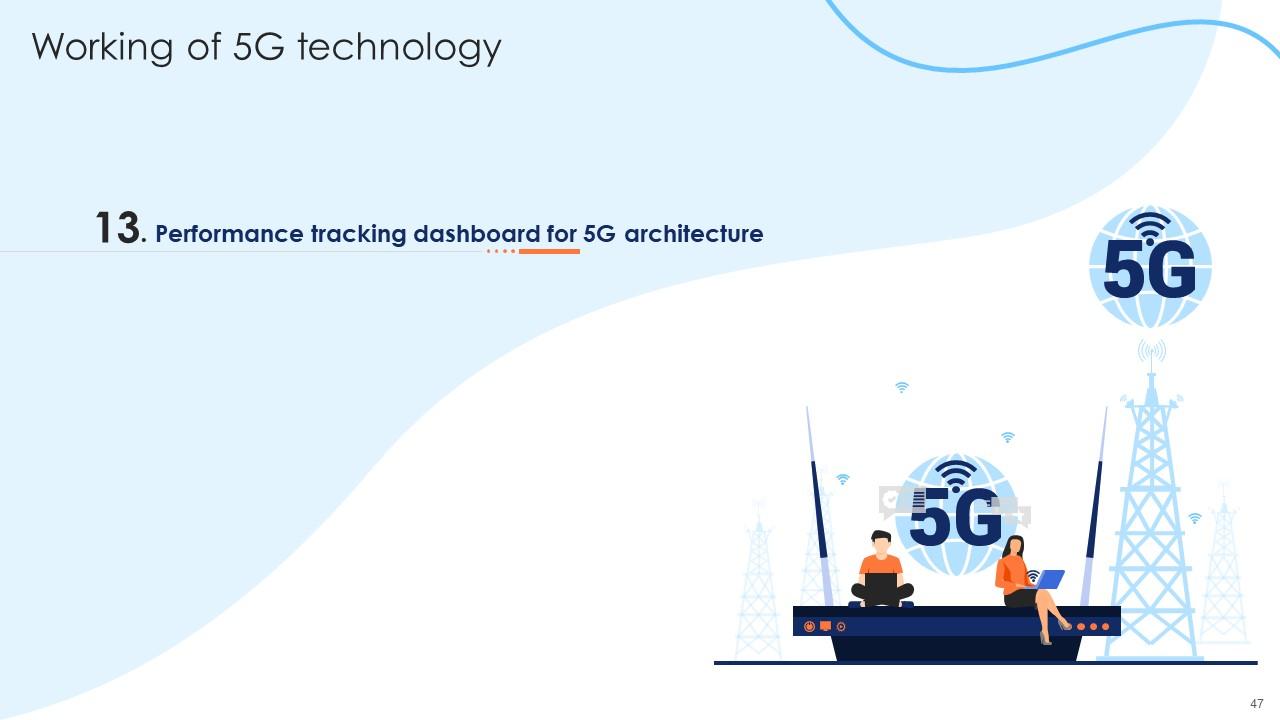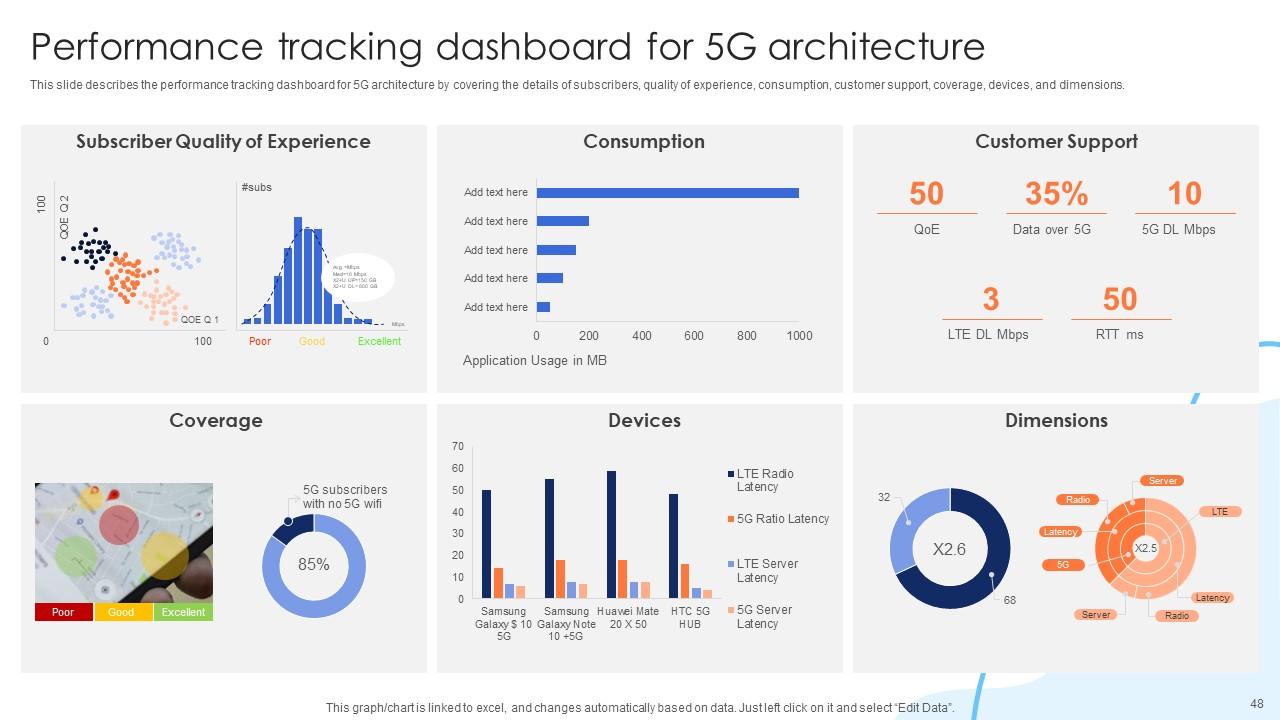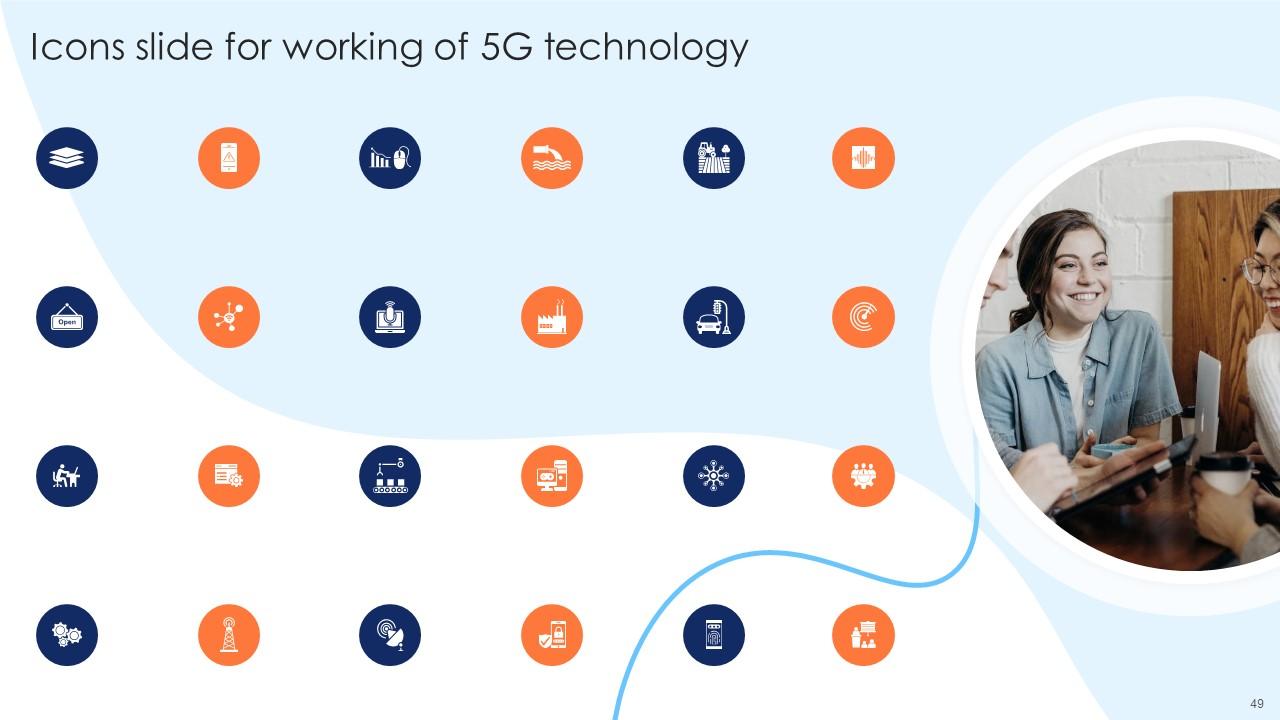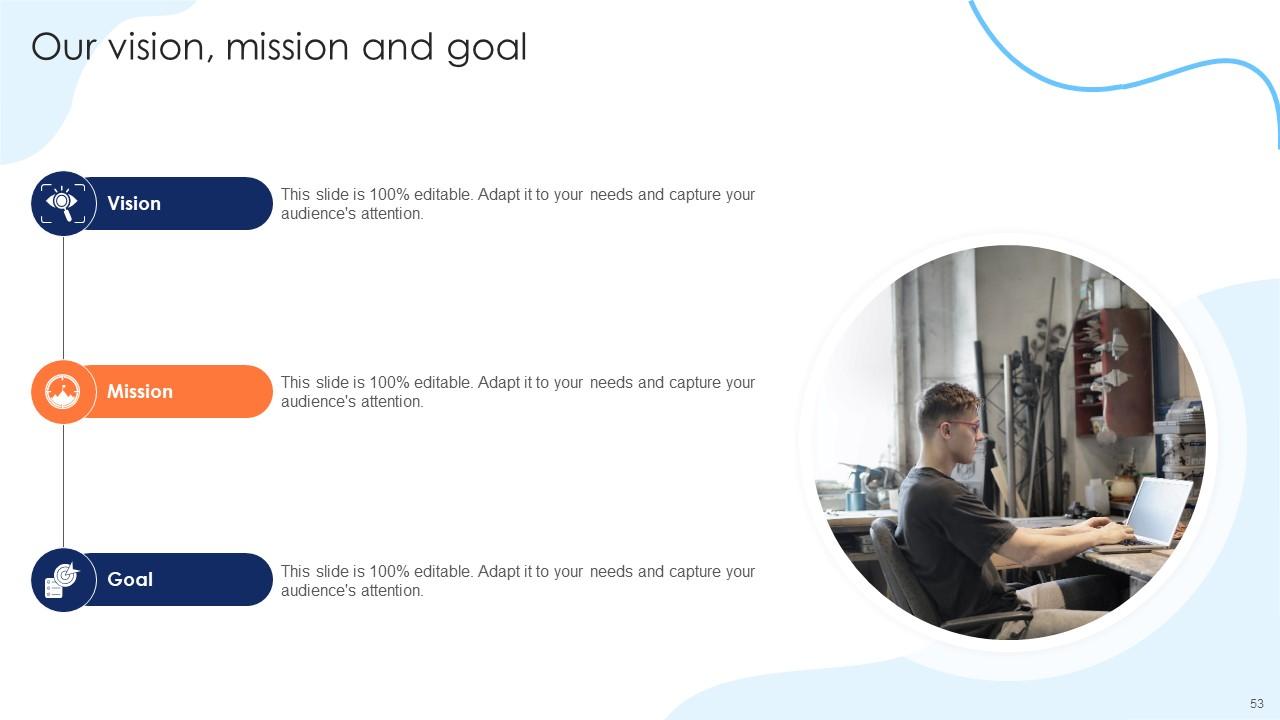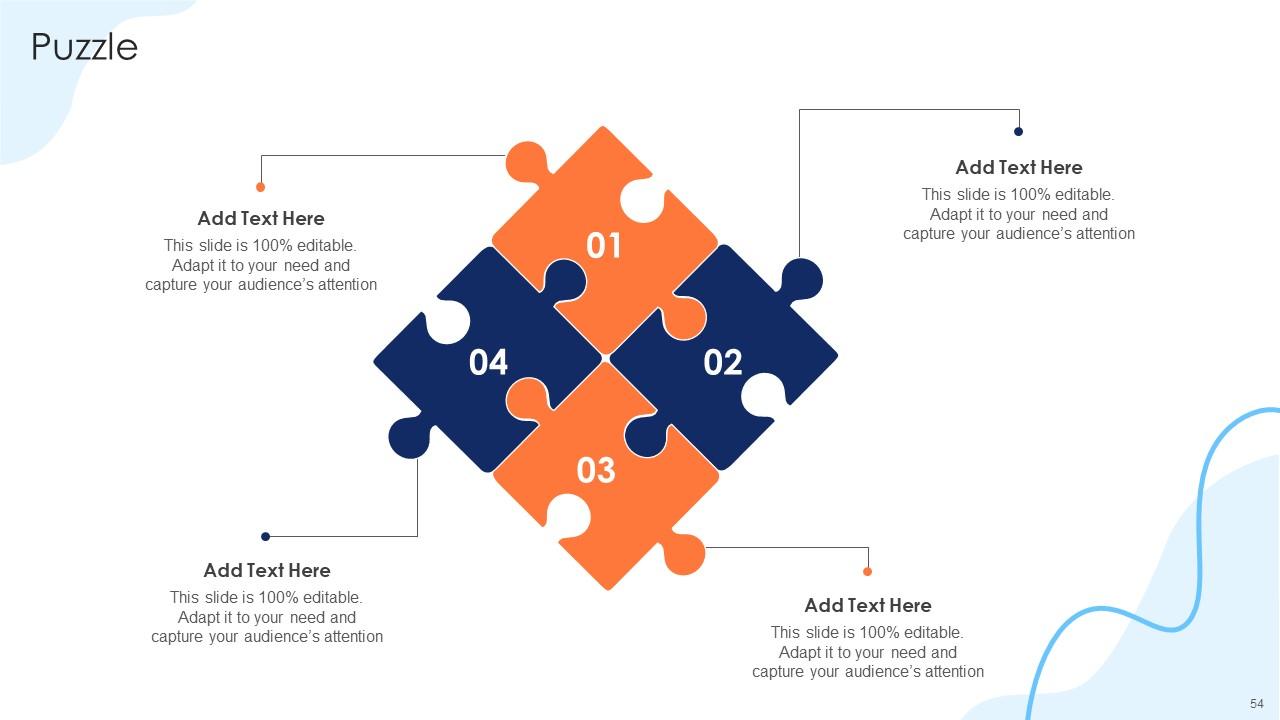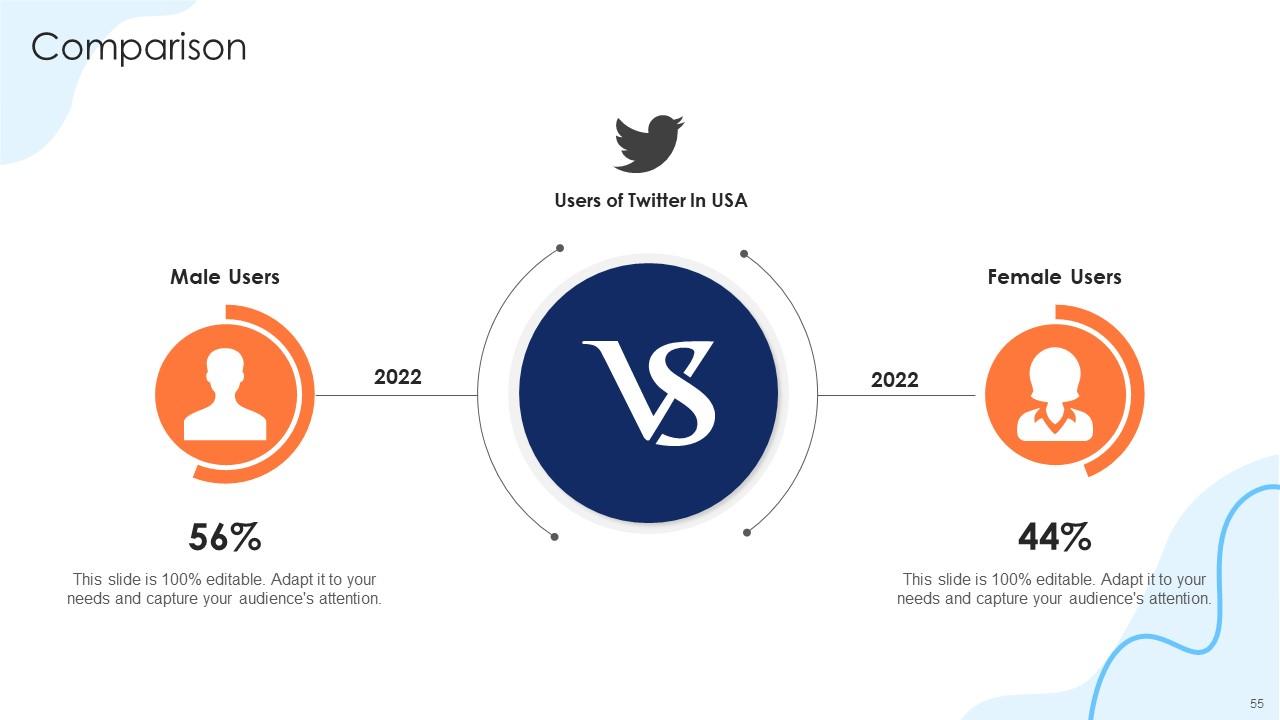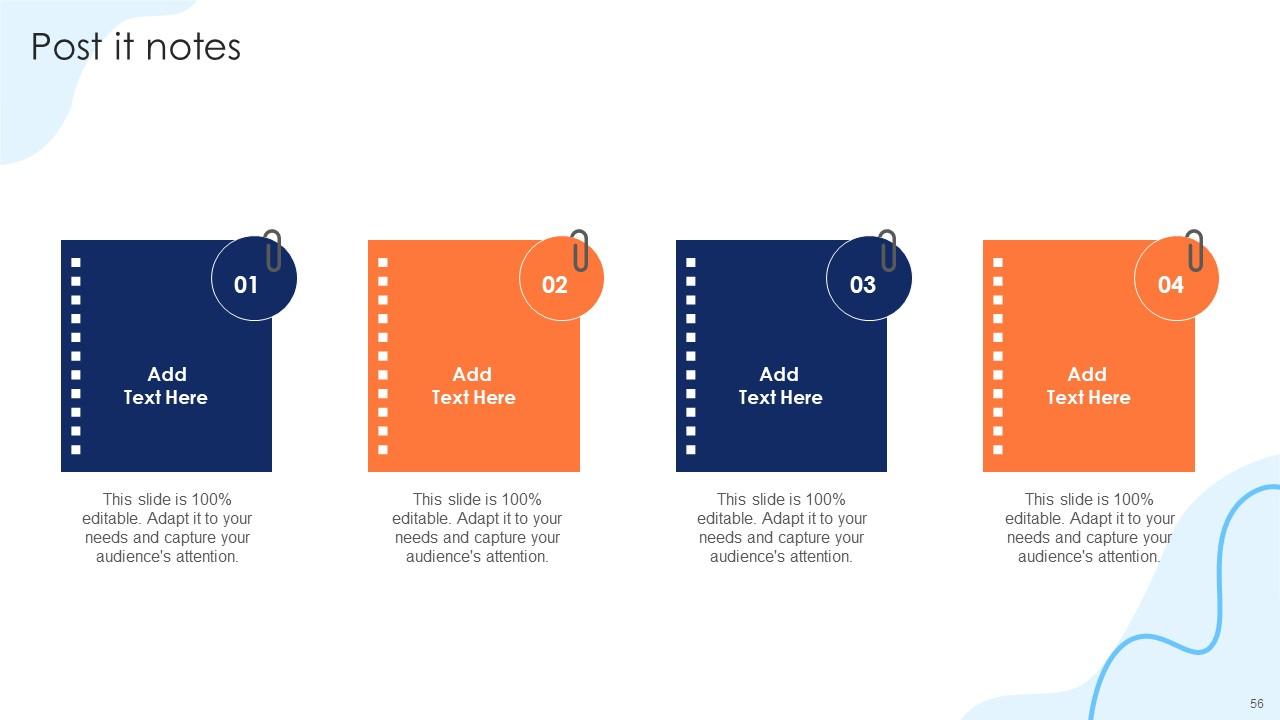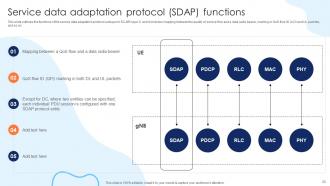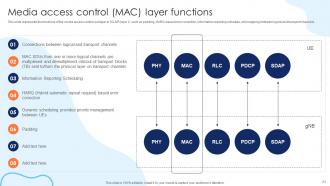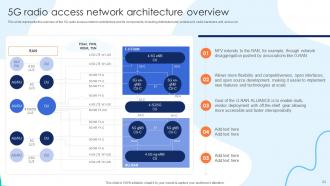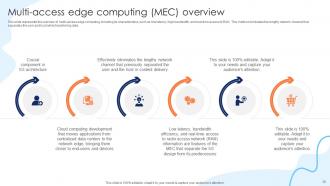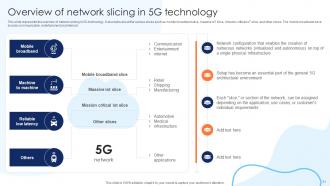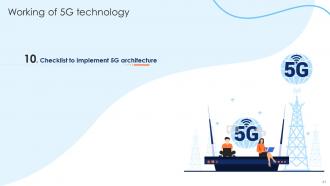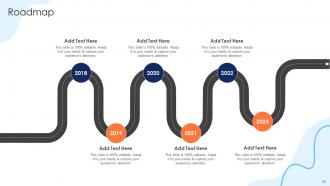Working Of 5G Technology Powerpoint Presentation Slides
5G wireless technology delivers higher multi Gbps peak data speeds, ultra low latency, and more reliability to enhance the users experience. Grab our efficiently designed Working of 5G Technology IT template. It presents a brief idea about the architecture and functioning of 5G technology, including the evolution of 5G technology from 1G to 5G. Our 5G Generic Architecture deck includes slides depicting 5G protocol layers mapped with an OSI stack, 5G architecture design and planning considerations, and 5G NR deployment options. It also shows the various types of 5G architectures, like 5G generic networks, 5G network topologies, etc. Further, our 5G NR Standard Architecture PPT includes NR RRC, NR U plane, SDAP, etc. It also incorporates a 5G radio access network, a 5G core architecture, and much more. Furthermore, our 5G Core Architecture presentation exhibits 5G architecture functional components like frequency bands at the core of 5G networks, MEC, network slicing, a checklist to implement 5G architecture, and many more. Lastly, the module showcases a timeline, a roadmap for implementing 5G architecture, and a 5G architecture performance tracking dashboard. Get access now.
- Google Slides is a new FREE Presentation software from Google.
- All our content is 100% compatible with Google Slides.
- Just download our designs, and upload them to Google Slides and they will work automatically.
- Amaze your audience with SlideTeam and Google Slides.
-
Want Changes to This PPT Slide? Check out our Presentation Design Services
- WideScreen Aspect ratio is becoming a very popular format. When you download this product, the downloaded ZIP will contain this product in both standard and widescreen format.
-

- Some older products that we have may only be in standard format, but they can easily be converted to widescreen.
- To do this, please open the SlideTeam product in Powerpoint, and go to
- Design ( On the top bar) -> Page Setup -> and select "On-screen Show (16:9)” in the drop down for "Slides Sized for".
- The slide or theme will change to widescreen, and all graphics will adjust automatically. You can similarly convert our content to any other desired screen aspect ratio.
Compatible With Google Slides

Get This In WideScreen
You must be logged in to download this presentation.
PowerPoint presentation slides
Enthrall your audience with this Working Of 5G Technology Powerpoint Presentation Slides. Increase your presentation threshold by deploying this well-crafted template. It acts as a great communication tool due to its well-researched content. It also contains stylized icons, graphics, visuals etc, which make it an immediate attention-grabber. Comprising fifty nine slides, this complete deck is all you need to get noticed. All the slides and their content can be altered to suit your unique business setting. Not only that, other components and graphics can also be modified to add personal touches to this prefabricated set.
People who downloaded this PowerPoint presentation also viewed the following :
Content of this Powerpoint Presentation
Slide 1: This slide introduces Working of 5G Technology (IT). Commence by stating Your Company Name.
Slide 2: This slide depicts the Agenda of the presentation.
Slide 3: This slide incorporates the Table of Contents.
Slide 4: This is yet another slide continuing the Table of Contents.
Slide 5: This slide highlights the Title for the Topics to be discussed next.
Slide 6: This slide depicts the evolution of 5G technology from 1G to 5G, including the rate of speed, the demand for mobile handsets, and the technology used by each generation.
Slide 7: This slide exhibits the Heading for the Components to be discussed further.
Slide 8: This slide represents the 5G protocol layers mapped with Open Systems Interconnection Model.
Slide 9: This slide reveals the Title for the Ideas to be covered in the forth-coming template.
Slide 10: This slide describes the design and planning considerations for 5G architecture, and how it should fulfill the high-demand application requirements.
Slide 11: This slide states the Heading for the Ideas to be discussed further.
Slide 12: This slide depicts the 5G NR deployment architecture options broadly categorized into two segments.
Slide 13: This slide presents the Title for the Contents to be covered next.
Slide 14: This slide portrays the overview of the 5G generic network architecture.
Slide 15: This slide represents the overview of the 5G network topology architecture and its components.
Slide 16: This slide shows the 5G architecture as per the 5G NR standard.
Slide 17: This slide elucidates the overview of the 5G radio protocol stack architecture.
Slide 18: This slide represents the overview of 5G-New Radio layer 3 radio resource control functions.
Slide 19: This slide exhibits the layer 2 structure of the New Radio U-Plane radio protocol.
Slide 20: This slide outlines the functions of the service data adaptation protocol sublayer in 5G-NR layer 2.
Slide 21: This slide depicts the packet data convergence protocol sublayer functions.
Slide 22: This slide covers the functions of the radio link control sublayer.
Slide 23: This slide represents the functions of the media access control sublayer in 5G-NR layer 2.
Slide 24: This slide reveals the overview of the 5G radio access network architecture and its components.
Slide 25: This slide talks about the overview of 5G core architecture and its components.
Slide 26: This slide depicts 5G core network architecture functions.
Slide 27: This slide highlights the functional architecture of context and content-aware 5G platforms.
Slide 28: This slide incorporates the Heading for the Topics to be discussed next.
Slide 29: This slide talks about the three frequency bands at the core of 5G networks.
Slide 30: This slide represents the overview of multi-access edge computing, including its characteristics.
Slide 31: This slide showcases the overview of network slicing in 5G technology.
Slide 32: This slide displays the overview of network function virtualization and 5G and how it works as software to replace different network tasks.
Slide 33: This slide describes the overview of beamforming in 5G technology.
Slide 34: This slide contains the Title for the Topics to be further discussed.
Slide 35: This slide deals with Security in 5G technology architecture.
Slide 36: This slide represents the security architecture in 5G technology.
Slide 37: This slide exhibits the Heading for the Ideas to be covered in the following template.
Slide 38: This slide depicts edge computing within the 5G network architecture.
Slide 39: This slide portrays the Title for the Topics to be dicussed next.
Slide 40: This slide compares 4G and 5G network architecture based on components and their placement in the architecture.
Slide 41: This slide incorporates the Heading for the Components to be coverd further.
Slide 42: This slide represents the checklist for implementing 5G architecture.
Slide 43: This slide elucidates the Title for the Ideas to be covered next.
Slide 44: This slide represents the timeline for implementing 5G architecture.
Slide 45: This slide reveals the Heading for the Ideas to be discussed next.
Slide 46: This slide reveals the roadmap for implementing 5G architecture.
Slide 47: This sldie highlights the Heading for the Ideas to be further discussed.
Slide 48: This slide describes the performance tracking dashboard for 5G architecture by covering the details of subscribers, quality of experience, etc.
Slide 49: This is the Icons slide containing all the Icons used in the plan.
Slide 50: This slide displays Additional information.
Slide 51: This is Meet our team slide for stating the team-related information.
Slide 52: This is the About us slide. State your company-related information here.
Slide 53: This slide presents the organization's vision, mission and goal.
Slide 54: This is the Puzzle slide with related imagery.
Slide 55: This slide is used for the purpose of Comparison.
Slide 56: This slide contains the Post it notes for reminders nad deadlines.
Slide 57: This is the 30 60 90 days plan slide for efficient planning.
Slide 58: This slide exhibits the Roadmap of the firm.
Slide 59: This is the Thank You slide for acknowledgement.
Working Of 5G Technology Powerpoint Presentation Slides with all 64 slides:
Use our Working Of 5G Technology Powerpoint Presentation Slides to effectively help you save your valuable time. They are readymade to fit into any presentation structure.
FAQs
The evolution of mobile technology can be traced from 1G to 5G. Each generation has brought about significant changes in speed, the demand for mobile handsets, and the technology used. 5G is the latest and fastest generation of mobile technology, offering increased speeds, low latency, and greater capacity.
Design and planning considerations for 5G architecture include ensuring that the architecture fulfills high-demand application requirements, is scalable and adaptable to future technology, and ensures efficient use of resources. It should also be designed to ensure high availability, security, and reliability.
5G NR deployment architecture options are broadly categorized into two segments: Non-Standalone (NSA) and Standalone (SA). The NSA architecture leverages the existing 4G LTE infrastructure, while the SA architecture is an independent deployment of 5G infrastructure.
The 5G radio access network architecture comprises multiple components such as gNB, NG-RAN, and Uu interface. The gNB connects to the core network, while the NG-RAN is the radio access network that connects the UE to the gNB. The Uu interface is the air interface between the UE and the NG-RAN.
Network slicing in 5G technology is the concept of dividing a single physical network into multiple virtual networks, each with a specific set of characteristics and capabilities. Network slicing works by creating multiple logical networks, each with its own set of resources and capabilities, allowing for greater flexibility and customization of services.
-
Wow, never been this impressed with any online service provider. Really appreciate the customer support all along from the navigation to purchasing the right products.
-
Unique and attractive product design.


